Christmas/New Year- 10
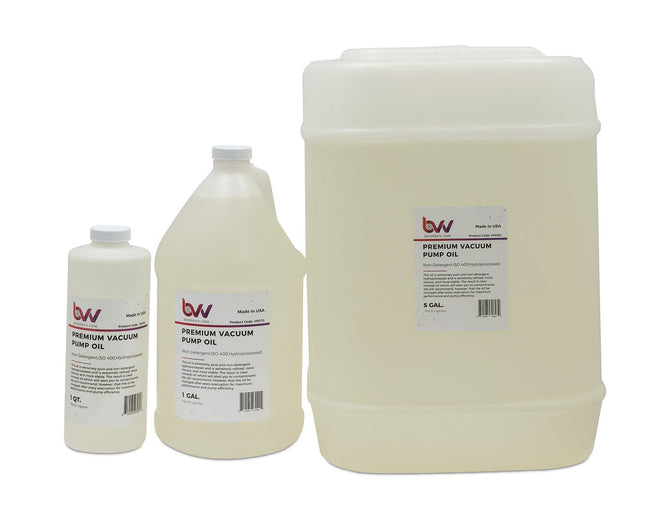
Premium Vacuum Pump Oil
Premium Vacuum Pump Oil For Maximum performance and pump efficiency, change the oil after every evacuation. After evacuation, oil contains contaminants which limit pump efficiency. Premium vacuum pump oil can be used in any vacuum pump to maintain and prolong the life of the pump. Drain immediately after evacuation while pump is warm. Slowly add oil to top of "oil level" line. If oil is to low, you will hear the exhaust baffle chatter. If oil level is too high, excess oil will be blown out of the exhaust. Non detergent-Extra Pure-Hydroprocessed-ISO 400 BVV Vacuum Pump Oil Certificate of Analysis COA BVV Vacuum Pump Oil Safety Data Sheet SDS
$12.00 - $950.00
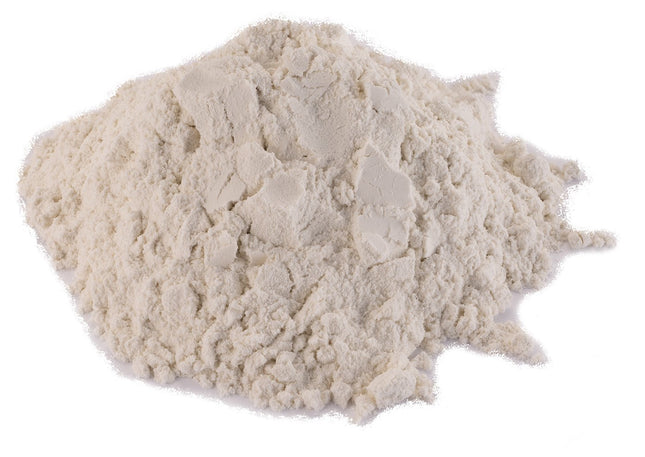
Celite® 545 Diatomaceous Earth (Food Codex Grade) 4.5 Micron
Celite® 545 Food Codex Chemicals Grade Filters down to 4.5 microns BVV™'s Celite 545 grade is Food Codex Grade and is approved for use as a filtering and processing aid in the Food Industry & is Made in the USA. Celite 545 is a formulation of Diatomaceous Earth that is used as a filtration aid for the pre-processing of distillate. Diatomaceous earth is considered skeletal remains of single-celled algae/diatoms formed due to sedimentary deposits. This filtration aid is used in laboratory settings and is a surface-active filtration agent that causes abrasion and the adsorption of other materials such as plant lipids. Celite 545 or Diatomaceous Earth is also an effective, safe alternative to chemical pesticides. This ultra-fine powder should be used with the proper safety equipment and should not be inhaled due to the risk of causing respiratory damage. pH: 10 (10% in Water) 90Kg Size sold at 4x 50lb bags on a Mini-Pallet* Safety Data Sheet Technical Data Sheet Certificate of Analysis Note: Bulk Bags and Bulk sizes are non-stocked items and will be ordered as needed and carry a several weeks lead time and require a forklift or pallet jack
$15.00 - $5,100.00
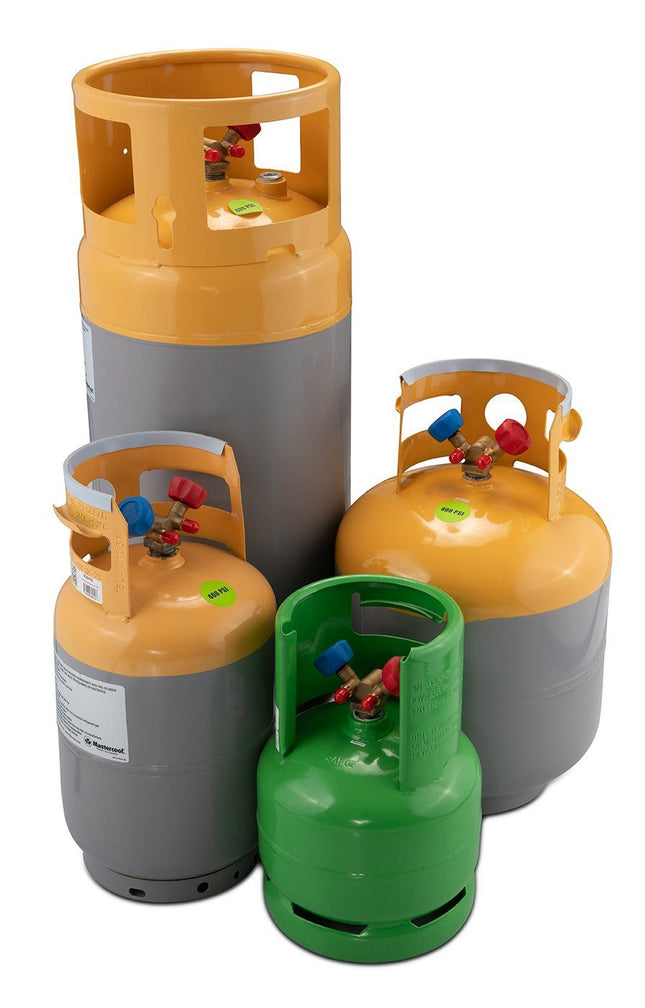
DOT-Approved Recovery Cylinders
LP Carbon Steel Refrigerant Tank Carbon Steel LP Tanks are the best choice when storing solvents for the long term because of their reliability and inherent safety mechanisms. These tanks are the standard in LP storage and transportation because of their conformance to strict DOT guidelines and UL listings. They come pre-charged with nitrogen gas to help create a dry interior to inhibit the formation of rust on the interior of the tank. Note: When storing these tanks empty the user must either backfill them with nitrogen or maintain and full vacuum to prevent moisture from creating rust on the interior. ***Note: Tank comes charged with nitrogen and does not include solvent and the 1/4" flared connections do not require Teflon tape. Key Features: Valve Type: HVAC Y-Valve 1/4" SAE(Valve Rated for 5 Years) Service Pressure: 400 PSI 1/4" and 3/4" NPT Ports for float switch and other add-ons. Reusable and conforms to DOT-4BA400 specifications and ARI guidelines. The tank is Pre-Charged with Nitrogen gas to provide a clean, dry interior. High gloss powder coated finish for durability. Tank Sizes Available: 6L Mastercool 61010-EUGRN - (NOT DOT RATED) 30# 50# 100# 61010-EUGRN: Y-valve for liquid/vapor TPED approved Single valve for vapor TPED approved Raised collar for ease of handling and protection Tanks Conform to PED and ADR regulations CE and TÜV approved Used for storage and transport of refrigerant gases Size (w x h): 185 mm x 338 mm Standard Specification: ADR/RID2009, EN13322-IN D TUV 1 Service Pressure: 32 bar Air Tightness Pressure: 32 bar Bursting Volumetric Expansion Rate: >20% Tare Weight: 5.18 kg Nominal Water Capacity: 6 l Tank Test Pressure: 48 bar Bursting Pressure: >108 bar Body Material: HP295 1/4″ FL-M (7/16-20) connection Color: green Butane Capacity Calculation: All solvent tanks sold by Best Value Vacs have their capacity determined by this calculation and are based on industry standard nomenclature of the water weight tank # system because the specific gravity of water is 1.000 and the DOT 80% fill guideline. Example: 100# Tank = ~100lbs of water weight, Halfton Tank = 1000lbs of water weight. Tank # Water Weight in Lbs Specific Gravity of Butane 0.601 80% Fill Guidline 0.800 (Tank #) * (Specific Gravity of Butane) * ( 80% Fill Guildine) Specifications Tank/Component Material Carbon Steel/Brass Specifications Met D.O.T. 4BA, D.O.T. 4BW Connection Type(s) 1/4" (7/16-20) SAE Flared Butane Capacity: 6L 6lbs 30# 14.424 50# 24.040 100# 48.080
$98.00 - $325.00
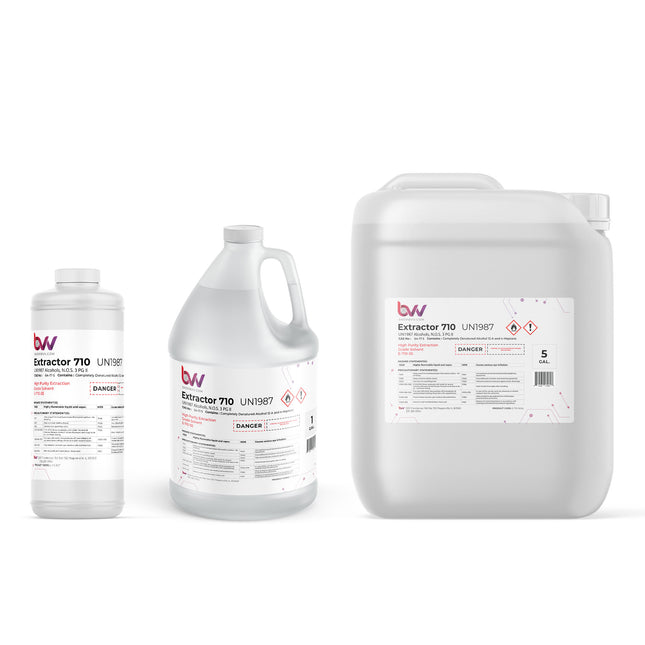
CDA-12A Denatured Ethanol n-Heptane
Ultra High Purity n-Heptane Denatured Ethanol - CDA 12A HAZMAT ITEMS ARE NON-REFUNDABLE. ALL SALES ARE FINAL (Note: Container style and color may vary) BVV's Ultra High Purity N-Heptane Denatured Ethanol (CDA 12A) is distinguished by its exceptional purity, Our CDA 12A formulation combines 95% Food Grade/USP/ACS 200 Proof Ethanol, derived from corn, with 5% high-purity N-Heptane. Adhering to stringent industry standards, ensuring it meets the precise requirements of our customers, our Ultra High Purity Heptane Denatured Ethanol excels across diverse applications widely adopted as an effective botanical extraction solvent and cleaning agent. Being that our Ultra High Purity Denatured Ethanol is made unfit for consumption when denatured with N-Heptane it is not subject to the Federal Excise Tax on alcohol saving you up to 72% without compromising on it suitability for top-tier extractions. Primarily utilized as pure ethanol in extraction processes, this solvent is favored for its cost-effectiveness and extraction efficiency. Reduce manufacturing costs and increase extraction efficiency with BVV's Ultra High Purity Heptane Denatured Ethanol. Key Features: Significantly Reduced Cost due to the absence of Federal Tax Produces Exceptional Quality Extractions Leaves No Residuals or Tastes Evaporates Completely in a Rotary Evaporator Chemical Formula: Ethanol C2H6ON-Heptane C7H16 Molecular Weight: 72.1057 CAS Registry Number: Ethanol 64-17-5N-Heptane142-82-5 Appearance Colorless Liquid Odor: Mint or acetone-like Density 0.7905g/cm³ Boiling Point: 78.5c/173.3F Solubility in water: Miscible GHS Pictograms: GHS Signal Word: Danger GHS Hazard Statements: H225, H319 GHS Precautionary Statements P210, P233, P240, P241, P242, P243, P261, P264, P271, P280, P303+P361+P353, P304+P340, P305+P351+P338, P312, P337+P313, P370+P378, P403+P233, P403+P235, P405, P501 UN Identification Number: 1987 Proper Shipping Name: Alcohols, N.O.S Transport Hazard Class: 3 Packing Group: I DOT Placard: What is Denatured Ethanol? Denatured ethanol, also known as denatured alcohol, is ethanol (ethyl alcohol) that has been rendered unfit for human consumption by the addition of denaturants. Denaturants are typically chemicals that make the ethanol taste bad or have toxic effects, and they are added to discourage people from drinking the substance. The denaturation process is done to avoid the high taxes and regulations associated with beverage alcohol, as denatured ethanol is intended for industrial, pharmaceutical, or cosmetic uses rather than for consumption. Common denaturants include heptane, methanol, isopropyl alcohol, acetone, and other chemicals. Denatured ethanol is widely used in various industries, such as in the production of paints, solvents, cleaning products, and as a fuel for alcohol burners. Why is Ethanol Denatured? Ethanol is denatured, or rendered undrinkable, for several reasons: Tax Purposes: Denaturing ethanol allows for the imposition of lower taxes on industrial or non-beverage alcohol compared to potable alcohol. Governments often place higher excise taxes on alcohol intended for human consumption. Regulatory Compliance: Denaturing ethanol is a regulatory requirement to discourage the illegal diversion of tax-free industrial alcohol for beverage use. The addition of denaturants makes it unpalatable and unsafe for consumption. Public Safety: Making ethanol undrinkable helps prevent accidental or intentional ingestion of industrial alcohol, which can be toxic. Denaturing agents are chosen to deter people from attempting to use denatured alcohol as a substitute for beverage alcohol. Industrial Use: Denatured ethanol is widely used in various industries, including pharmaceuticals, cosmetics, and manufacturing. It serves as a solvent, fuel, or raw material in these applications. Common denaturants include substances like heptane, methanol, isopropanol, and various chemicals that make the alcohol unsuitable for human consumption while maintaining its usability in industrial processes. The specific denaturing formulations, such as CDA 12-A mentioned earlier, are defined by regulatory agencies to ensure compliance with safety and tax regulations. What is denatured ethanol used for? Denatured ethanol is used for various industrial and commercial purposes where the alcohol is needed for its properties but should not be consumed. Here are some common applications: Industrial Solvent: Denatured ethanol is widely used as a solvent in industries such as pharmaceuticals, cosmetics, and manufacturing. It is effective in dissolving a variety of substances. Cleaning Agent: Due to its solvent properties, denatured ethanol is used as a cleaning agent for surfaces, equipment, and machinery in industrial and commercial settings. Fuel Additive: Denatured ethanol is sometimes used as a fuel additive, especially in the blending of gasoline. It can improve combustion efficiency and reduce emissions. Paint and Coating Industry: It is used as a solvent in the formulation of paints, varnishes, and coatings. Pharmaceuticals: Denatured ethanol is used in the pharmaceutical industry for various purposes, including the extraction of medicinal compounds. Laboratory Use: In laboratories, denatured ethanol is often used for tasks like sterilization and as a solvent for experiments. Inks and Dyes: It is employed in the production of inks and dyes due to its ability to dissolve pigments. Adhesives and Sealants: Denatured ethanol is used in the formulation of adhesives and sealants. Window Cleaning: It is used in commercial window cleaning solutions. Automotive Industry: In the automotive industry, denatured ethanol is used for cleaning and degreasing. What can be used to denature ethanol? Here are examples of common Completely Denatured Alcohol (CDA) formulations used to denature ethanol: CDA 12-A To every 100 gallons of alcohol, add either: Five gallons of heptane or 5 gallons of toluene. CDA-19 To every 100 gallons of ethyl alcohol (not less than 160 proof), add: 4.0 gallons of either methyl isobutyl ketone, mixed isomers of nitro propane, or methyln-butyl ketone 1.0 gallon of either kerosene, deodorized kerosene, gasoline, unleaded gasoline, rubber hydrocarbon solvent, or heptane. CDA-20 To every 100 gallons of ethyl alcohol (not less than 195 proof), add a total of: 2.0 gallons of either unleaded gasoline, rubber hydrocarbon solvent, kerosene, or deodorized kerosene, or any combination of these. What does CDA mean? Completely Denatured Alcohol (CDA) is a type of denatured alcohol that has been rendered unfit for human consumption by the addition of denaturing agents. Denatured alcohol is ethanol (ethyl alcohol) that has been intentionally adulterated to make it toxic, foul-tasting, or otherwise undrinkable. This denaturing process is done to exempt the alcohol from excise duty and other taxes, as it's not intended for use in beverages. The denaturing agents used in CDA can vary, but they often include chemicals such as methanol, isopropanol, or other substances that make the alcohol unpalatable and potentially harmful if ingested. The specific formulation of denatured alcohol may be regulated by government authorities to ensure it meets safety standards and legal requirements. CDA is commonly used in industrial applications, as a solvent, fuel, or as a cleaning agent. It's important to note that due to the addition of denaturing agents, CDA should not be used for purposes that involve contact with the human body or ingestion. Safety precautions, including proper ventilation, should be followed when working with denatured alcohol. What is CDA 12A? CDA 12-A is a formulation specified by the Alcohol and Tobacco Tax and Trade Bureau (TTB) for Completely Denatured Alcohol (CDA). The formula is defined under §21.26 as Formula No. 12-A. The composition of CDA 12-A is as follows: For every 100 gallons of alcohol, add either: 5 gallons of n-heptane or 5 gallons of toluene. This denaturing process renders the ethanol unfit for consumption while meeting regulatory requirements for various industrial applications. CDA formulations, including CDA 12-A, are used to denature ethanol for purposes such as industrial solvents, cleaning agents, and manufacturing processes. Can you remove heptane from CDA 12A? When n-Heptane is added to ethanol it creates an azeotrope between the ethanol and n-heptane. An azeotrope is defined as a mixture of two liquids that have a constant boiling point and composition through distillation. This azeotrope results in the ethanol and n-heptane evaporating at the same temperature, making it extremely difficult to separate the two through distillation. While these azeotropic solvents are still easily recovered from a botanical extract at a relatively low boiling point around 78C/173F using a rotary evaporator or falling film evaporator, it is near impossible to separate the two via distillation. What is an Azeotrope? An azeotrope is a mixture characterized by having identical concentrations in both its vapor and liquid phases. This stands in contrast to ideal solutions, where one component is usually more volatile than the other, allowing for separation through distillation. When an azeotrope forms, the concentrations in both phases remain the same, hindering separation through traditional distillation methods. Azeotropes consist of a blend of at least two different liquids, and this mixture can exhibit either a higher or lower boiling point than either of its individual components. Azeotropes become relevant when certain liquid fractions resist alteration through distillation processes. In typical mixtures, components can be extracted using Fractional Distillation, a process involving repeated distillation stages. The more volatile component vaporizes and is collected separately, while the less volatile component remains in the distillation container, resulting in two distinct, pure solutions. BVV™ 710 Extraction Solvent Safety Data Sheet (SDS) Pure Ethyl Alcohol USP Product Data Sheet (PDS) CDA-12 with nHeptane Certificate of Analysis (COA)
$12.00 - $1,675.00
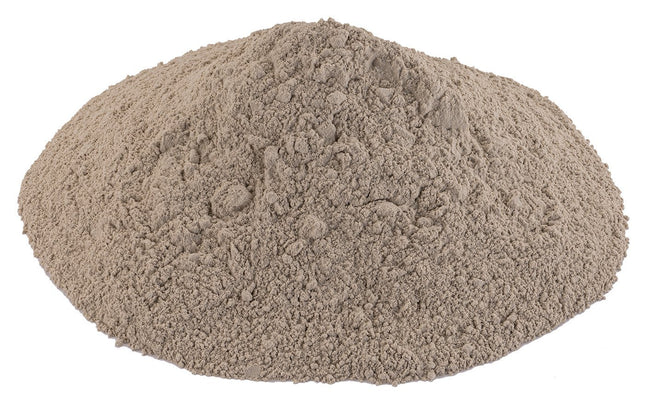
Activated Bentonite Clay T-5™
Activated Bentonite Clay T-5™ BVV™ activated Bentonite Clay T-5™ is a highly effective decolorizing agent for filter organic materials. This Clay is tan in color and is Heat Activated to help remove Anthocyanin pigments while preventing isomerization. This is a slow filtering media but will produce high clarity when used as a filter aid. pH:5 BVV™ Activated Bentonite Clay T-5™
$22.00 - $1,925.00
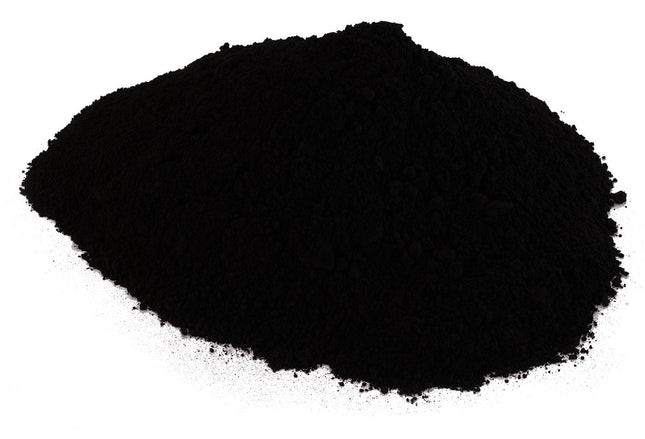
Activated Hardwood Carbon (Charcoal)
Activated Carbon Decolorizing T1 100% Hardwood NSF 61 & UL Classified for food and Consumption Contact BVV™ Activated Carbon or Charcoal powder is some of the highest purity and quality activated charcoal on the market. Made in the USA, and 100% Hardwood. Activated charcoal can be used for several processes in the laboratory and can be most importantly used for the removal of color, unwanted chemical impurities, and unwanted flavors in the starting material resulting in a more refined purer end substance. Each bag includes a 5cc scoop inside. pH:7NSF 61 Certified & UL Classified. Guaranteed the product is free of harmful chemicals, and can be used in systems that humans come into contact consuming. Lot certificates can be available per request. BVV™ Activated Carbon Technical Data Sheet BVV™ Activated Carbon Decolorizing T1 SDS Note: Bulk Bags and Bulk sizes are non-stocked items and will be ordered as needed and carry a several weeks lead time and require a forklift or pallet jack
$48.00 - $3,500.00
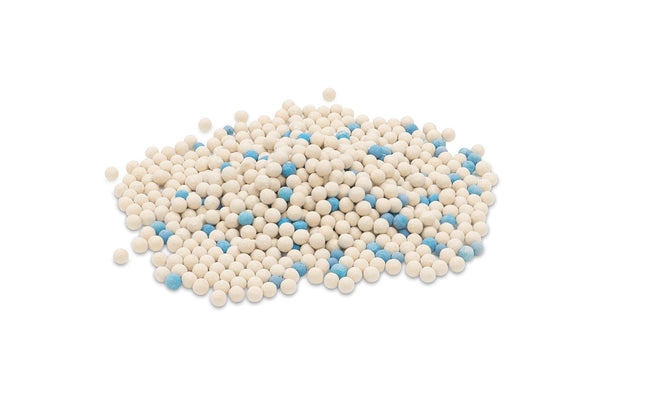
Molecular Sieve Beads Type 4A
Molecular Sieve Beads Type 4A This bag contains both blue moisture indicating molecular sieve and also normal molecular sieve. The blue molecular sieve is a sodium alumina silicate molecular sieve impregnated with an inorganic metal salt moisture indicator. The desiccant will perform as a 4a molecular sieve plus with the additional ability to visually determine when the molecular sieve reaches saturation. When active, the molecular sieve beads are blue, as the beads reach saturation the color changes to beige indicating that the molecular sieve has reached equilibrium capacity and is in need of replacement. While the white molecular sieve is an alkali alumino-silicate in the spherical form. It is the sodium form of the Type A crystal structure with an effective pore opening of approximately 4A. It will adsorb molecules such as oxygen, nitrogen, carbon dioxide and straight chain hydrocarbons. Aromatics and branched chain hydrocarbons will not be absorbed. Key Features: Natural Gas Drying The desiccant is known to act as a molecular sieve with the bonus ability to tell visually when the molecular sieve achieves saturation A sodium alumina silicate molecular sieve with inorganic metal salt moisture indicator Dehydration of highly polar compounds, such as methanol and ethanol More efficient than older silica gel and alumina desiccants Crystalline composition Ease of Use Molecular Sieve 4A Technical Data Sheet Molecular Sieve 4A Safety Data Sheet Specifications: Type: 4A Bead Size: 4mm Includes Blue moisture indicating beads Nominal Pore Opening: 4 Angstroms Equilibrium Water Capacity @ 25°C: >= 22% Weight Heat of Adsorption: 1800 BTU/lb of H2O Note: 20lb size comes as set of 2x 10lb containers. Size Recommendations: 2LB - Will fit our Molecular Sieve Filter Drier 4LB - Will fit our XL Molecular Sieve Filter Drier
$25.00 - $1,250.00
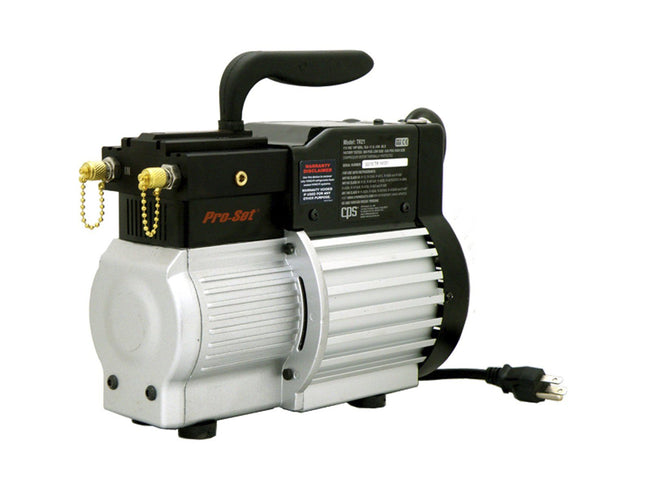
CPS TRS21 Anti-spark/explosion pump
The TRS21 is an Anti-Spark/Explosion pump designed and built specifically for R-600, Ignition Proof Construction meets ANSI/ISA 12:12.1 The pump can be used to recirculate the solvent through the system increasing speed of processing and yield, or just to reclaim the solvent to greatly increase recovery time to minutes. The Upgraded version of the TRS21 comes pre-installed with higher quality internal components that increase recovery speed drastically and also comes with 3/8" JIC and SAE Flares to reduce restrictions in the pump and increase flow/recovery rates. Upgraded Version Includes: Hand Rebuilt in the USA with premium upgraded materials and parts. Custom Hand Set piston displacement for each cylinder set. Standard Stainless Steel 1/4" Flares + 3/8" JIC flares included Food Grade Grease and Lubricants in bearings and wristpins. Custom 2 Piece Stainless Pistons for easy rebuilds GEN III Piston Seals (lasts 700% longer than the original OEM seals from CPS) Viton O-Rings (vs Chinese OEM seals that come with the standard unit) Upgraded unit Warranty covers butane users for 1 year from BVV! Standard units are not warrantied. Key Features: • CPS TRS21 R-600 Recovery Pump, 2 Cylinder Oil-Less Compressor Specifications: • Recovery Rates: Vapor- 2.5lb/min, Liquid-12lb/min • Ignition Proof Construction ANSI/ISA 12:12.1 • Power : 115 VAC, 60 Hz, 10 Amps • Power: 850 watts • Filtration: Internal 100 mesh Screen integrated into Suction Port • Weight : 24 LBS MaintenancePlease note regular maintenance and replacement of seals is NOT covered under warranty as these are normal wear and tear items. Compressor Seals will require re-build after 200-240hrs of operation, depending on use. We stock the following compatible rebuild kits for your convenience: Upgraded TRS21 Rebuild Kits: TRS21 Upgraded Top Piston Assembly TRS21 Upgraded Stainless Steel 2-Piece Piston and Rod Design for Hydrocarbon Extraction TRS21 Upgraded Compressor head SS ¼” SAE 45D IN and OUT fittings TRS21 Complete Connecting Rod Assembly Upgrade Kit TRS21 2 Piece Piston Tool CPS Rebuild Kits: TR21X1 Valve Rebuild Kit TR21X2 Complete Rebuild Kit TR21X3 Piston Rebuild Kit TR21X4 Head Rebuild Kit ***DISCLAIMER TO CUSTOMER: Running any solvent that is not authorized by CPS voids all warranty. Running any solvent mixed with any organic plant material will instantly void all warranty. Any Odor coming from the pump or organic plant residuals will also void all warranty.
$995.00
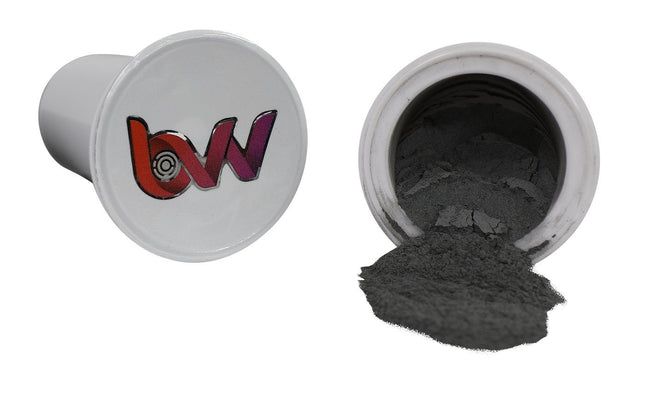
AFS Disposable Color Bleach / B80 Cartridge *FDA Certified Material
AFS Disposable Color Bleach Cartridge Note: Stainless Steel filter housing sold separately. (Click Here for Housing) AFS Instruction Manual Download Here AFS Filters are the first and only disposable color remediation filter cartridges for the botanical extraction industry. The Patent Pending design allows for an easy to use solution implemented into existing extraction systems; and is now available as a standard integration from many equipment manufacturers. AFS Filters are a simple solution that allows for the use of prepackaged filters, which are available in different recipes depending on the application. With the integrated 2.5µm paper filter molded and sealed into the cup there is no media leak through. Pre-packed means there's no need to be an expert in remediation filter media and how to construct filters; as well as eliminates the messy process of building/packing filters yourself. Disposable offers no need for cleaning the filter housings afterwards and trying to un-clog stainless filter screens. Less R&D investment, less mess, and less down time allows for higher throughput and more profit. The media contained in the BVV™ Color Bleach filter cartridge is a low pH Pure-Flo® Perform 6000 bentonite clay in a 10:1 ratio of BVV™ T-1 Activated Hardwood Carbon. Using only made in the USA materials that are FDA-GRAS and NSF certified. *The results show are using the same material for each extraction. Butane only method vs. BVV™ color bleach (110g filled Cartridge) Light Filtration is the trimmed down version of the standard Medium filter. These are best suited for extractions using fresh high end input materials that only needs a light cleaning. Medium Filtration is our standard go-to filter. This is the most commonly used and sold filter. It's great for general filtration and lightening of extracted products. Heavy Filtration is packed with the highest amount of active extraction media. These filters are best suited for exceptionally dark extractions or for extractions with normal input materials where the desired outcome is closer to clear. Heavy filters offer the highest level of filtration. Technical Specifications: Life Span: 1 Time use, Good for 5-7 lbs. of dry material. Temperature Rating: -40°C-70°C Top Seal: Induction Sealed (No glue is used) Filter: Cellulose Paper Pressure Rating: Recommended 60psi, Paper will hold 80-90 psi Max. Media: Low pH bentonite clay in a 10:1 ratio of activated 100% hardwood carbon, USA Made Materials and Certificates of Analysis available. Shell Material: Polypropylene Excellent compatibility and Safe for chemicals in our industry (Butane, Propane, Ethanol). Pressure Method: Nitrogen Assist, unless you open blast CRC. Then you can assist with an air compressor. AFS Cup weight: 48g Media Fill Volume: 110-120g Recommend Minimum Biomass: 1lb (lesser biomass will see drastic yield losses) AFS Safety Data Sheets *Please recycle your spent Cartridges. *Yield losses under refinement are to be expected but overall potency will be retained and will proportionally increase.
$55.00 - $627.00
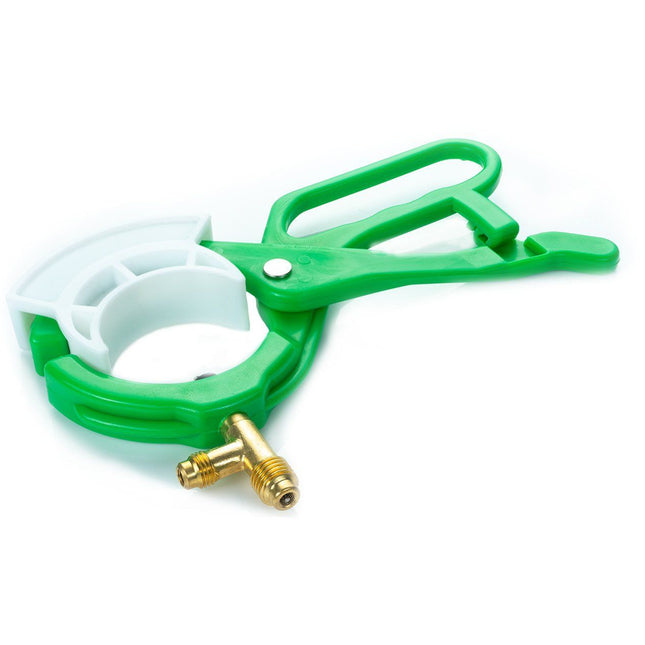
Can Tap Tool
Can Tap Tool. This product allows a much simpler adjustment for quick charge on refrigerant drums. This product also includes an adapter to ensure proper fitting. This item will require a hose made to depress the Schrader valve within the fitting, such as 41601.
$19.00
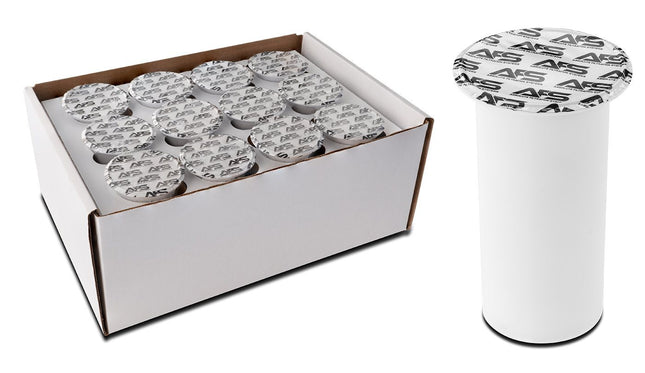
AFS 2.5" Disposable Color Remediation Cartridge
AFS Disposable Color Remediation Cartridge Note: Stainless Steel filter housing sold separately. (Click Here for Housing) AFS Instruction Manual Download Here AFS Filters are the first and only disposable color remediation filter cartridges for the botanical extraction industry. Our Patent Pending design allows for an easy to use solution implemented into existing extraction systems and is now available as a standard integration from many equipment manufacturers. AFS Filters are a simple solution that allows for the use of prepackaged filters, which are available in different recipes depending on the application. With the integrated 2.5µm paper filter molded and sealed into the cup, there is no media leak through. Pre-packed means there's no need to be an expert in remediation filter media and how to construct filters; as well as eliminates the messy process of building/packing filters yourself. Disposable offers no need for cleaning the filter housings afterward and trying to un-clog stainless filter screens. Less R&D investment, less mess, and less downtime allows for higher throughput and more profit. These come in light, medium, and heavy filtration. Learn more about each: Light Filtration is the trimmed down version of the standard Medium filter. These are best suited for extractions using fresh high-end input materials that only needs a light cleaning. Medium Filtration is our standard go-to filter. This is the most commonly used and sold filter AFS offers.. It's great for general filtration and lightening of extracted products. Heavy Filtration is packed with the highest amount of active extraction media. These filters are best suited for exceptionally dark extractions or for extractions with normal input materials where the desired outcome is closer to clear. Heavy filters offer the highest level of filtration. Technical Specifications: Life Span: 1 Time use, 5-7 lbs. of dry material. Temperature Rating: -40°C-70°C Top Seal: Induction Sealed (No glue is used) Filter: Cellulose Paper Pressure Rating: Recommended 60psi, Paper will hold 80-90 psi Max. Media: Proprietary licensed recipe. Shell Material: Polypropylene Excellent compatibility and Safe for chemicals in our industry (Butane, Propane, Ethanol). Pressure Method: Nitrogen Assist, unless you open blast CRC. Then you can assist with an air compressor. Click here to see SDS Sheet *Please recycle your spent Cartridges.
$42.00 - $528.00
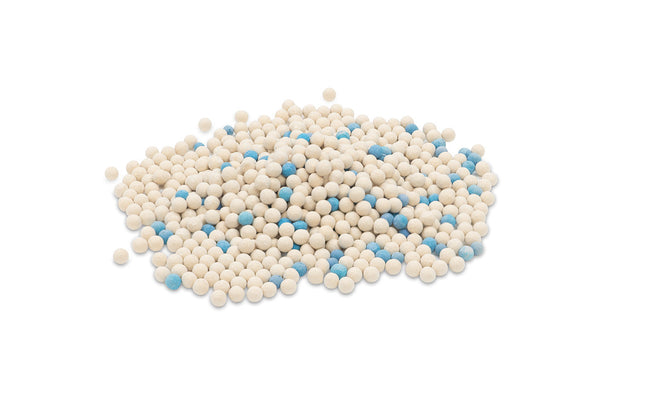
Molecular Sieve Beads Type 13X (10A)
Molecular Sieve Beads Type 13X 13X molecular sieve is a multiple purpose, highly porous, high capacity alkali metal alumino-silicate in the spherical form. It is the sodium form of the Type X crystal structure with pore diameters of approximately 10A. It can adsorb all molecules that can be adsorbed by 3A, 4A, and 5A molecular sieve. Type 13X molecular sieve can also adsorb molecules such as aromatics and branched-chain hydrocarbons, which have large critical diameters. Handling & Storage Recommendations: Store in a dry location to prevent unintentional water adsorption. Reseal packages after opening to prevent contamination and unintentional water adsorption. We recommend that you rotate stock so oldest material is used first. Please read the safety data sheet to ensure proper handling and always wear personal protection equipment when handling molecular sieve. Product Data and Safety Information: Molecular Sieve 13X Technical Data Sheet Molecular Sieve 13X Safety Data Sheet Note: 20lb size comes as set of 2x 10lb containers.
$25.00 - $1,400.00
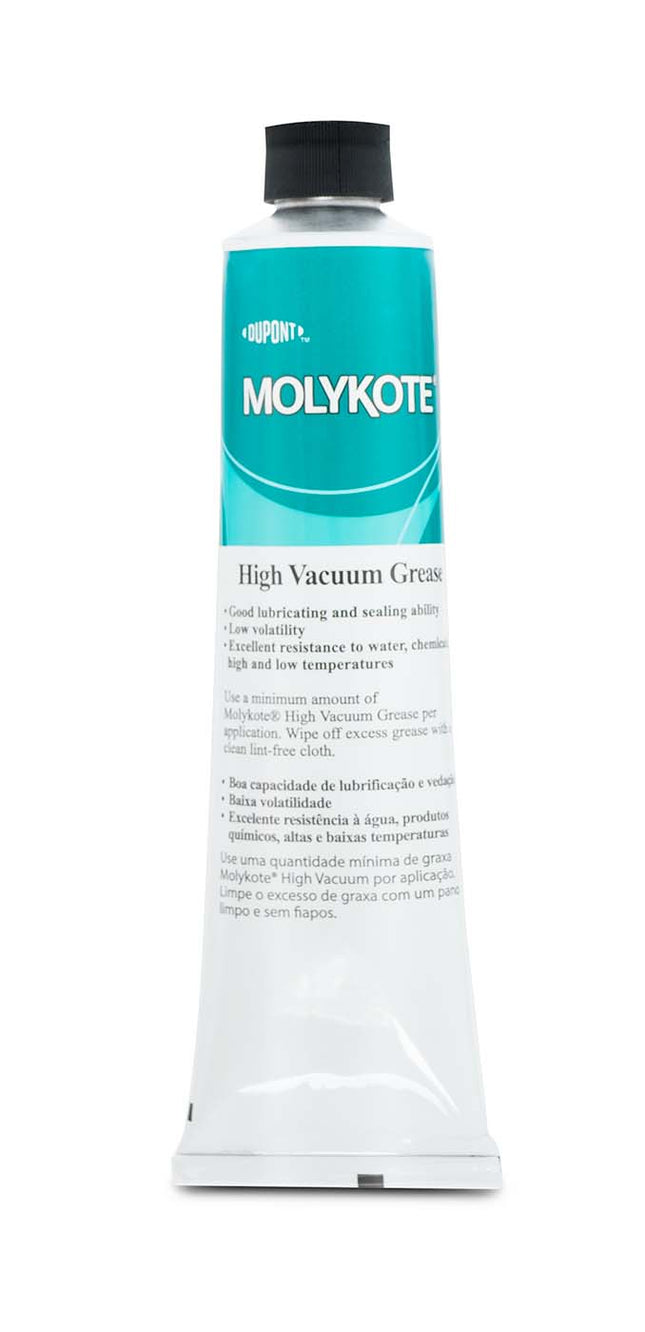
MOLYKOTE® High Vacuum Grease 150g
Key Properties: NLGI Grade 3-4, translucent white, used primarily in sealing vacuum and pressure systems. Molykote Technical Data Sheet Molykote Safety Data Sheet Applications: Seals and lubricates chemical processing equipment. Lubricating plug valves, control valves, flow meter bearings, ceramic plug cocks, fire extinguisher valves, water treating equipment, synthetic rubber gaskets and seals in high-temperature applications. Sealing vacuum and pressure systems. Lubricating O-rings in binoculars and telescopes; prevents fogging of delicate lenses. Performance Benefits: Reduces wear in plastic-to-metal and rubber-to-metal contact Low volatility Excellent resistance to water, chemicals, and high and low temperatures Meets requirements of FDA 21 CFR 175.300 Good chemical resistance Good oxidation resistance Good plastic & rubber compatibility Good water resistance High tack & adhesion High temperature performance Low temperature performance Wide temperature range Product Details: Product type: Compounds Technology: Silicone NLGI Grade: 3-4 Thickener: Silica Low Temp: (C) -40 High Temp: (C) 204 Color Translucent: White
$39.00
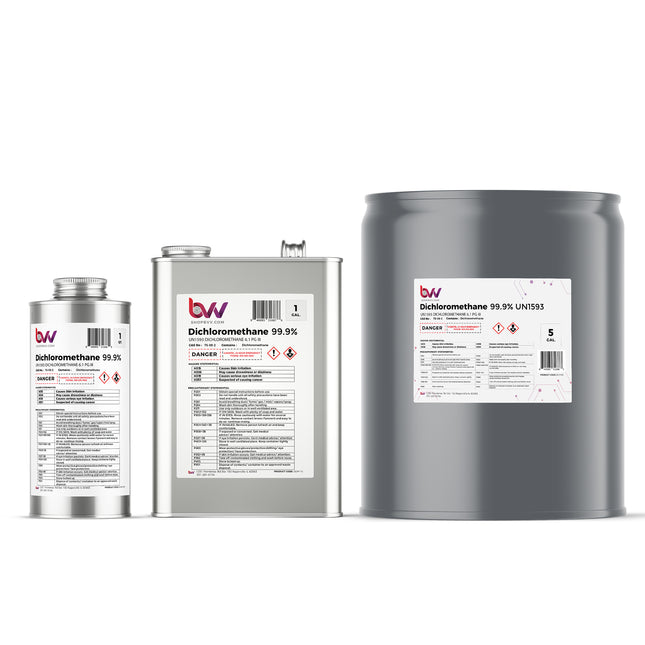
Dichloromethane (Methylene Chloride) Lab Grade
Dichloromethane (DCM) Lab Grade Tested 99.99% Purity (Aka. Methylene Chloride) Dichloromethane is an organochloride that appears as a colorless volatile liquid having sweet chloroform-like odor. This liquid is widely used as a solvent. Although it is not miscible with water, it is polar, and miscible with most organic solvents. Commonly used for partitioning alkaloids from aqueous solutions Dichloromethane or DCM for short is commonly used as an extraction solvent across the food & beverage industry and is well known for its use in the decaffeination of coffee. With a density of 1.33g/cm3 it is denser than water partitioning as the bottom layer during liquid-liquid extraction. With a low boiling point of 39.8C/103.3F Dichloromethane allows for fast drying and the preservation of temperature-sensitive compounds. While Dichloromethane is highly volatile it is actually neither flammable nor explosive in air. Produced through the chlorination of methane along with chloromethane, trichloromethane (chloroform), and tetrachloromethane (carbon tetrachloride, Dichloromethane is the least toxic of the three. While Dichloromethane is less toxic than other chlorinated hydrocarbons it is still known to cause skin and serious eye irritation and may cause drowsiness or dizziness and potentially cancer. During handling always wear appropriate personal protective equipment in the form of tightly fitting safety goggles or face shield, long-sleeved clothing, and an approved respirator if exposure limits are exceeded or if irritation or other symptoms are experienced. Always ensure DCM is handled under adequate ventilation using a chemical fume hood. Avoid getting DCM into the eyes, on skin, or on clothing, and avoid ingestion and inhalation. Dichloromethane should always be stored in a dry, cool, and well-ventilated place with the container tightly closed. Chemical Formula: CH2Cl2 Molecular Weight: 84.93 g·mol−1 CAS Registry Number: 75-09-2 Appearance Colorless Liquid Odor: Faint, Chloroform-like Density 1.3266 g/cm3 (20 °C) Boiling Point: 39.6 °C / 103.3 °F Solubility in water: 17.5 g/L (25 °C) GHS Pictograms: GHS Signal Word: Warning GHS Hazard Statements: H315, H319, H335, H336, H351, H373 GHS Precautionary Statements P261, P281, P305+P351+P338 UN Identification Number: 1593 Proper Shipping Name: Dichloromethane Transport Hazard Class: 6.1 Packing Group: III DOT Placard: What Is Dichloromethane? Dichloromethane, also known as methylene chloride, is a colorless, volatile, and sweet-smelling organic compound with the chemical formula CH2Cl2. It is a halogenated hydrocarbon and is commonly used as a solvent in various industrial and laboratory applications. What is Dichloromethane Used for? Dichloromethane, also known as methylene chloride, is a versatile organic compound with several common uses, including: Solvent: It is widely used as a solvent in various industrial and laboratory applications. Dichloromethane's ability to dissolve a wide range of organic compounds makes it valuable in chemical processes and as a cleaning agent. Extraction: It is used in some extraction processes, such as the decaffeination of coffee and tea. It can selectively dissolve caffeine from coffee beans or tea leaves, leaving behind other flavor compounds. Chemical Reactions: It is used in chemical reactions as a solvent and as a reagent in various synthetic procedures. Pharmaceuticals: In the pharmaceutical industry, dichloromethane can be used for various purposes, including as a solvent for drug formulation. Aerosol Propellant: It has been used as a propellant in aerosol products like paints and coatings. Foaming Agent: In the production of polystyrene foam, dichloromethane can be used as a foaming agent. Lab Applications: In laboratory settings, it is used as a solvent for analytical methods, especially in chromatography. What are the Properties of Dichloromethane? Dichloromethane, also known as methylene chloride, is a colorless, volatile liquid with several notable properties: Physical State: At room temperature (around 25 degrees Celsius or 77 degrees Fahrenheit), dichloromethane exists as a volatile liquid. It has a sweet, ether-like odor. Density: The density of dichloromethane is approximately 1.33 grams per milliliter (g/mL), making it denser than water. Solubility: Dichloromethane is highly miscible with a wide range of organic solvents, including ethers, alcohols, and chlorinated compounds. It exhibits limited solubility in water, forming an azeotrope with a maximum water concentration of around 12.5%. Boiling Point: It has a relatively low boiling point of approximately 39.6 degrees Celsius (103.3 degrees Fahrenheit), which makes it volatile and easy to evaporate. Reactivity: It is relatively chemically stable under normal conditions. However, dichloromethane can react with strong bases, such as sodium hydroxide, producing potentially hazardous compounds. Flammability: Dichloromethane is not highly flammable but can burn under certain conditions, particularly if it forms a vapor-air mixture within its flammable range. Toxicity: It is considered a hazardous chemical due to its potential health risks. Inhalation of dichloromethane vapors can lead to dizziness, headaches, nausea, and, in high concentrations, more severe health effects. Prolonged exposure can be harmful. Environmental Impact: Dichloromethane is known to be an ozone-depleting substance and can contribute to stratospheric ozone depletion. Consequently, its production and use are regulated or restricted in many countries under environmental laws. Industrial Use: Despite its potential hazards, dichloromethane is used in various industrial applications, such as paint stripping, as a solvent, and in the production of some chemicals and pharmaceuticals. What Are The Hazards Of Dichloromethane? Dichloromethane (DCM), also known as methylene chloride, is a volatile organic compound that poses several hazards to human health and the environment. It's important to handle DCM with care and follow safety precautions when working with this chemical. Here are some of the main hazards associated with dichloromethane: Inhalation Hazard: DCM is a volatile chemical, and its vapors can easily be inhaled. Short-term exposure to high concentrations of DCM vapor can lead to symptoms such as dizziness, headache, nausea, and in severe cases, loss of consciousness or death. Prolonged or repeated exposure to lower concentrations may cause respiratory irritation, coughing, and chest discomfort. CNS Depression: Dichloromethane can affect the central nervous system (CNS) when inhaled or absorbed through the skin. It has mild anesthetic properties and can lead to CNS depression, resulting in impaired coordination and reaction time. Skin and Eye Irritation: DCM can irritate the skin and eyes upon contact. It may cause redness, itching, and dermatitis. Eye contact can lead to irritation, tearing, and blurred vision. Carcinogenicity: Long-term exposure to DCM has been associated with an increased risk of cancer, particularly lung cancer. The International Agency for Research on Cancer (IARC) has classified DCM as a Group 1 carcinogen to humans. Environmental Impact: DCM is an ozone-depleting substance and can contribute to the depletion of the ozone layer when released into the atmosphere. It is also harmful to aquatic life, and its disposal into water bodies can have adverse effects on the environment. Flammability: While DCM itself is not highly flammable, its vapors can form flammable mixtures with air. It is important to take precautions to prevent the buildup of flammable vapor concentrations in enclosed spaces. Chemical Reactivity: DCM can react with certain chemicals, and its contact with strong oxidizers or alkalis can result in hazardous reactions. It should be stored and handled away from incompatible substances. To minimize the hazards associated with dichloromethane, it is essential to work with this chemical in a well-ventilated area, wear appropriate personal protective equipment (PPE), including gloves and eye protection, and follow safety guidelines and regulations. Use DCM in a chemical fume hood or a well-ventilated area to reduce inhalation exposure. Proper storage, handling, and disposal procedures should also be followed to protect human health and the environment. Additionally, it is advisable to be aware of local regulations and guidelines related to the use and disposal of DCM. How Do I Use Dichloromethane Safely? Using dichloromethane (DCM), also known as methylene chloride, safely is essential to minimize health and environmental risks associated with this chemical. Here are some guidelines for the safe use of DCM: Personal Protective Equipment (PPE): Wear appropriate PPE, including chemical-resistant gloves, safety goggles or a face shield, and a lab coat or chemical-resistant apron. Consider using a chemical-resistant apron and full-body protective clothing if handling large quantities of DCM. Ventilation: Work in a well-ventilated area, such as a chemical fume hood or a well-ventilated laboratory. Avoid working with DCM in confined spaces without proper ventilation. Respiratory Protection: If working with DCM outside of a fume hood or in a space with inadequate ventilation, use a NIOSH-approved organic vapor respirator to protect against inhalation exposure. Ensure that the respirator is fit-tested and properly maintained. Storage: Store DCM in a cool, well-ventilated area away from direct sunlight, heat, and incompatible materials. Keep containers tightly closed and labeled with hazard information. Handling: Use DCM only for its intended purposes and avoid unnecessary exposure. Handle DCM with care to prevent spills or splashes. Do not eat, drink, or smoke while working with DCM. Avoid Skin and Eye Contact: Wear chemical-resistant gloves to prevent skin contact. Use safety goggles or a face shield to protect your eyes from splashes. In case of skin contact, promptly remove contaminated clothing and wash the affected area thoroughly with soap and water. In case of eye contact, flush the eyes with water for at least 15 minutes and seek immediate medical attention. Work in a Controlled Environment: Perform DCM-related tasks on stable surfaces to prevent accidental spills. Avoid working alone when handling DCM, especially in situations where immediate assistance may be needed in case of an accident. Fire Safety: DCM is not highly flammable but can form flammable vapor-air mixtures. Keep ignition sources away from DCM and store it in a cool area. Ensure that fire extinguishing equipment is readily available and that personnel are trained in its use. Emergency Procedures: Know the location of emergency eyewash stations, safety showers, and spill response kits. Establish and familiarize yourself with emergency procedures in case of spills, fires, or exposure incidents. Disposal: Dispose of DCM waste according to local regulations and guidelines. DCM waste is often considered hazardous and must be handled and disposed of properly. Training: Ensure that personnel handling DCM are adequately trained in its safe use, storage, and disposal. Regulations and Guidelines: Be aware of and comply with local, state, and federal regulations governing the use, handling, and disposal of DCM. Remember that DCM is a volatile chemical, and its vapors can be harmful when inhaled over an extended period. Follow safety data sheet (SDS) instructions, and if you are uncertain about any aspect of using DCM safely, consult with a safety professional or chemical hygiene officer in your organization. Dichloromethane Specifications (Specs) Dichloromethane Safety Data Sheet (SDS) Dichloromethane Certificate of Analysis (COA)
$35.00 - $1,100.00
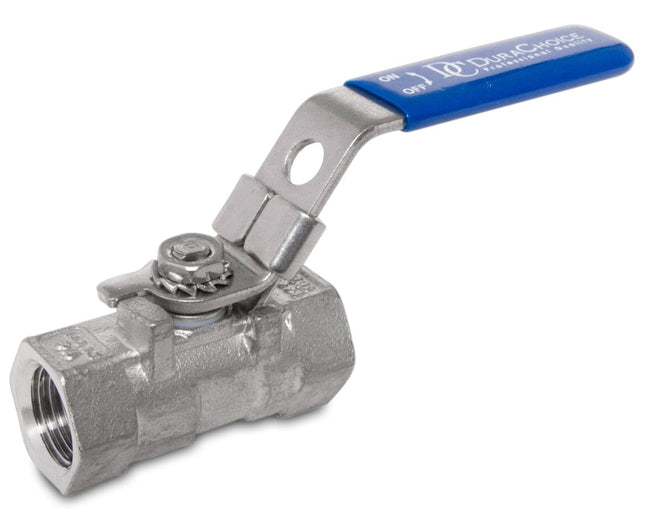
Stainless Steel (316) Ball Valve - 1 Piece Standard Port, 1,000 PSI (WOG)
DuraChoice 316 Stainless Steel Ball Valve - 1000WOG Stainless Steel (316) Ball The standard port VBS01 line is ready for action, with a 1000 psi rating, pure Teflon seats and seals, and a locking handle for added safety. Works with a wide variety of liquids and gasses. - 1pc Standard Port, 1,000 psi (WOG)SS316 Investment casting bodyWorking Pressure 1000 psi (WOG)Pure teflon seals and seatsSuitable for full range of liquids and gasTemperature range: -60 to 450 degree FahrenheitLow operation torque100% individually testedBlowout-proof stemFxF NPT Threaded ends to ANSI B1.20.1Heavy duty locking handles with blue vinyl insulatorDescription - MaterialBody - SS316 (CF8M)Ball - SS316 (CF8M)Cap - SS316 (CF8M)Ball Seat - RPTFEThrust Washer - PTFEStem Packing - PTFEStem - SS 304Packing Ring - SS 304Spring Washer - SS 304Stem Nut - SS 304Handle - SS 304Handle Lock - SS 304Handle Cover - PlasticPlease Note: Brass components in this product contain lead, known to the State of California to cause cancer and birth defects or other reproductive harm. California law requires that this warning be given to consumers.
$22.00 - $25.00
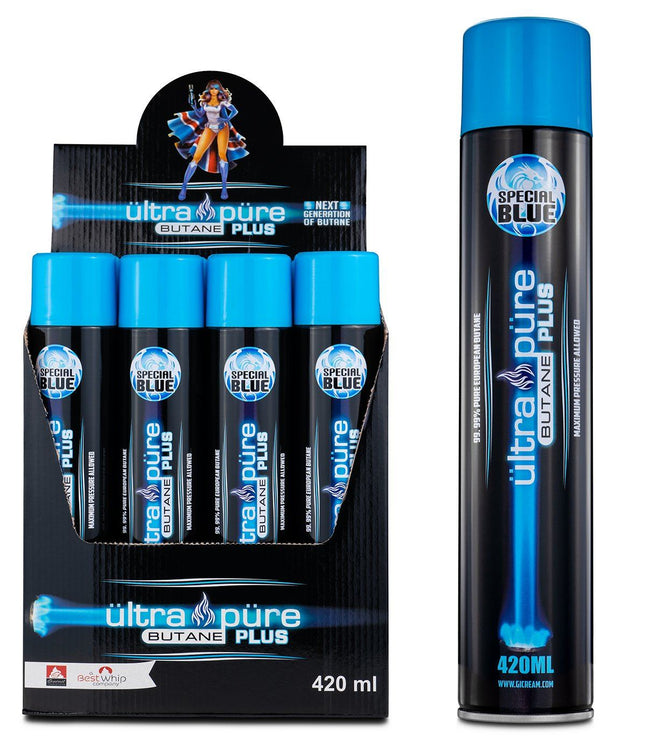
Ultra Pure PLUS 420ML Butane
Ultra Pure PLUS 420ML Butane 420ml Premium European Gas DISCLAIMER(S): This unit is intended for LEGAL purposes only, to be used in accordance with local laws and ordinances. Use only in WELL VENTILATED AREAS! Due to FAA regulations, solvent tanks cannot be safely transported via means other than ground. Any order that has solvent will not be shipped in an expedited fashion. If an order with solvent is combined with any other items and chosen to be expedited, that entire order will ship via Ground/Freight. We will not split up any orders and ship them separately. If a customer is wanting to expedite specific items and order solvent, 2 separate orders (1 for the solvent and 1 for the expedited items) will need to be placed in order to do so. Solvents do not ship to Hawaii, Puerto Rico, or any other US Territory outside of the contiguous 48 States. Shipping Solvent to Alaska may ONLY ship via freight and will be required to travel through Canada. California now prohibits the retail sale of any NON-Odorized butane in quantities larger than 150ml. If you are not a retail purchaser you can call in to place an order. Permitted Sales Include the Following: Medical Collectives or Cooperatives operating under CA Health & Safety Code Section 11362.775 Persons licensed to perform volatile solvent extraction activity under CA Bus & Prof Code Division 10 Manufacturers, wholesalers, resellers, or retailers solely for the purpose of resale UltraPure extra purified butane lighter refill gas is the PUREST European butane in the market. It is manufactured in the United Kingdom and meets both ISO and TUV regulations. It is sold with a lifetime warranty. Near zero impurities (99.995% pure butane fuel) Less than 5 parts per million impurities (ppm) Odorless Most recommended torch lighter refill Won't cause clogged burner valves or misfires Multiple tip adaptors 420ML Can Due to FAA regulations, solvent tanks cannot be safely transported via means other than ground. Any order that has solvent will not be shipped in an expedited fashion. If an order with solvent is combined with any other items and chosen to be expedited, that entire order will ship via UPS Ground/Freight. We will not split up any orders and ship them separately. If a customer is wanting to expedite specific items and order solvent, 2 separate orders (1 for the solvent and 1 for the expedited items) will need to be placed in order to do so. Solvents do not ship to Hawaii, Puerto Rico, or any other US Territory outside of the contiguous 48 States. Shipping Solvent to Alaska may ONLY ship via freight and will be required to travel through Canada. We have this policy in place to ensure safety when transporting solvents, and to prevent any issue with shipping times for our customers. Material Capacity Cylinder Volume Triclamp Spool (in) 1.5" 2" 3" 4" 6" 8" 10" 12" Length (in) 1" 2" 3" 4" 6" 8" 10" 12" 18" 24" 36" 48" Volume (in3) Select Material Butane ISO-Butane Propane How Much Will Fit in Cylinder FormulaVolume x Weight of Water x Specific Gravity ConstantsWeight of Water = 0.0360 (lbs / in3)Specific Gravity of = Lbs. of : Recommended: Account for an 80% fill to avoid a hydraulic lock How Much Material Will Fit in the Cylinder Packing Density (g) 2.5 3 3.5 4.3 Grams of Material Lbs. of Material
$5.00 - $220.00
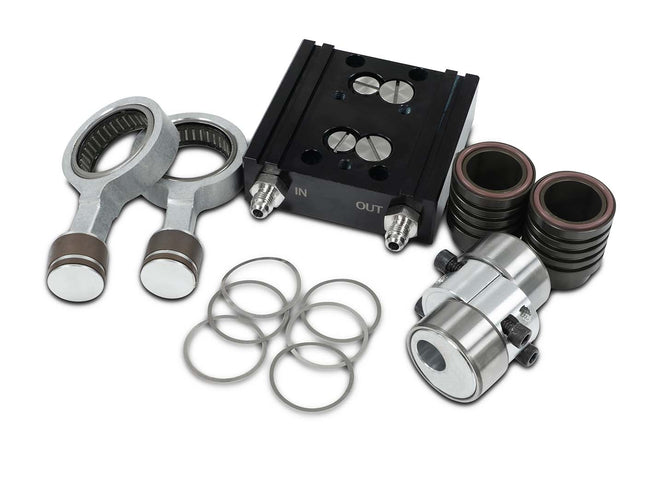
TR21X2 Complete Rebuild Kit
TR21X2 Complete Rebuild Kit. Please note: this item may be backordered at any time due to high volume ordering through CPS. Please excuse this inconvenience. TR21X2 CPS TR21 Oil-less Compressor Rebuild Kit. Includes TR21X4 Head, Pistons, Bearings, Eccentrics, Cylinders, O rings And Bolts. Oil-less Compressor Head Assembly Includes valves assembled ready to install. This kit is compatible with the following CPS pump(s): TRS 21 Recovery Pump TRS 600 Recovery Pump
$360.00
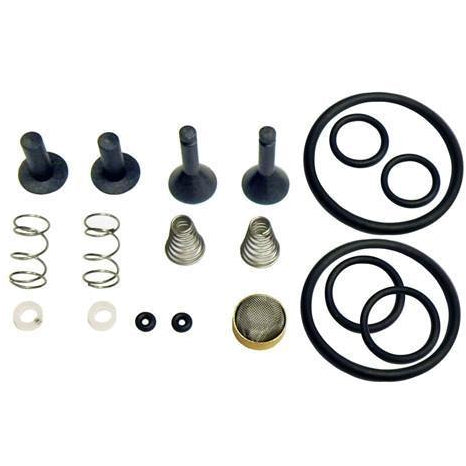
TRS21 Valve Rebuild Kit TR21X1
Specifications: CPS TR21 Oilless Compressor Valve Rebuild Kit includes valves, valve springs, seals and o-rings and inlet screen. This kit is compatible with the following CPS pumps: TRS 21 Recovery Pump TRS 19 Recovery Pump TRS 600 Recovery Pump
$70.00
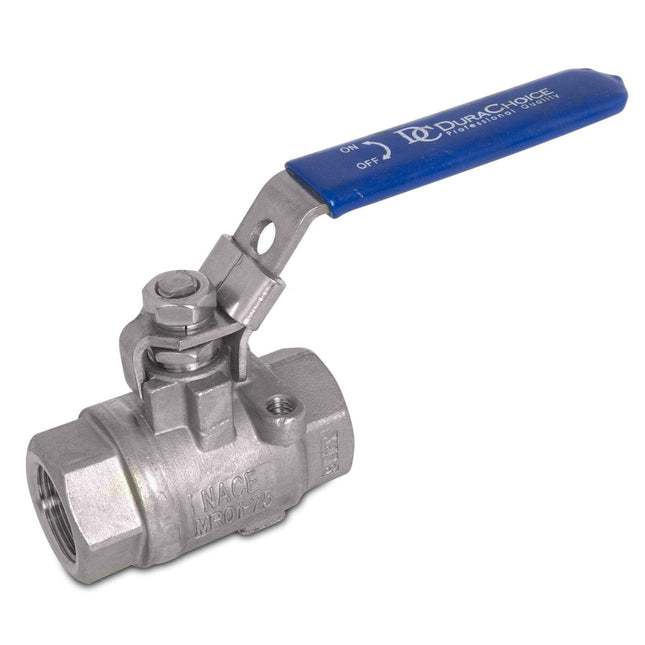
Stainless Steel 316 (CF8M) Seal Welded Full Port Ball Valve - 2,000 PSI (WOG)
DuraChoice Full Port Welded 316 Stainless Steel Ball Valve - 2000WOG Designed for petroleum and natural gas production, the VBS2KF line of high-pressure valves is pressure rated at 2,000 psi and formulated to resist the corrosion that can plague other ball valves in oilfield or refinery conditions. The valve is seal welded for additional strength.S.S. 316 (CF8M) investment casting, 2-piece full port body designWorking pressure of 2,000 PSI (WOG)Suitable for full range of liquids and gasesSeal weldedLow operation torque100% individually testedBlowout-proof stemNPT threaded ends to ANSI B1.20.1Meets NACE MR0175 standardISO 9001 StandardHeavy duty locking handle with insulator Designation - MaterialBody - SS 316 (CF8M)Ball - SS 304Cap - SS 316 (CF8M)Ball Seat - RPTFEThrust Washer - RPTFEStem Packing - PTFEStem - SS 304Gland Nut - SS 304Handle Washer - SS 304Handle Nut - A2-70Handle - SS 201Handle Lock - SS 201Handle Cover - Plastic
$40.00
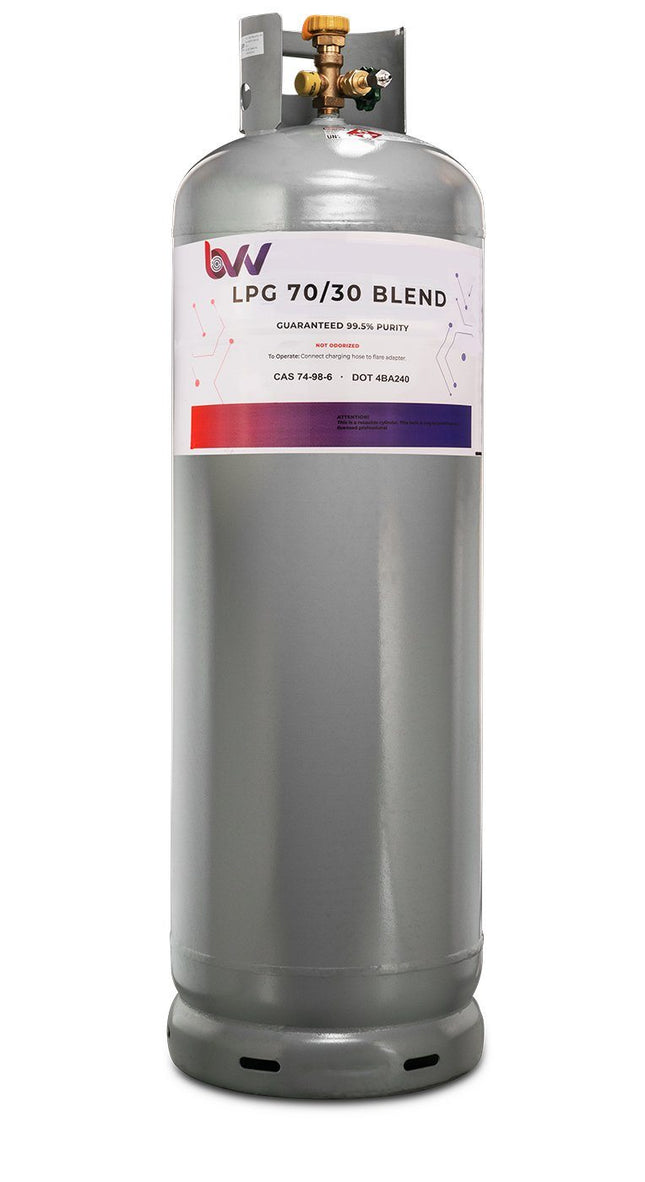
120LB DIPTUBE Tank High Purity USA 70/30% N-Butane/Propane Blend - 99.5% Guaranteed
120LB High Purity USA 70/30% N-Butane/Propane Blend DIPTUBE- 99.5% Guaranteed DISCLAIMER(S): This unit is intended for LEGAL purposes only, to be used in accordance with local laws and ordinances. Use only in WELL VENTILATED AREAS! Notice: This item will ship via Freight ONLY. BVV™ always recommends distillation of every solvent before use. Tank does not include CGA 555 fitting. Must be added through dropdown or bought separately. California now prohibits the retail sale of any Non-Odorized butane in quantities larger than 150ml. If you are not a retail purchaser you can call in to place an order. Actual 70/30% N-Butane/Propane Blend liquid weight is 115LB Permitted Sales Include the Following: Medical Collectives or Cooperatives operating under CA Health & Safety Code Section 11362.775 Persons licensed to perform volatile solvent extraction activity under CA Bus & Prof Code Division 10 Manufacturers, wholesalers, resellers, or retailers solely for the purpose of resale Ultra high purity 70/30% N-Butane/Propane is USA sourced, and guaranteed to be 99.5% pure. This instrument grade solvent helps to produce a higher quality extract by reducing mystery oils and contaminants. Solvent comes in a DOT refillable LP tank. *This product is clean, colorless and odorless. *Actual 70/30% N-Butane/Propane Blend liquid weight is 115LB Due to FAA regulations, solvent tanks cannot be safely transported via means other than ground. Any order that has solvent will not be shipped in an expedited fashion. If an order with solvent is combined with any other items and chosen to be expedited, that entire order will ship via UPS Ground/Freight. We will not split up any orders and ship them separately. If a customer is wanting to expedite specific items and order solvent, 2 separate orders (1 for the solvent and 1 for the expedited items) will need to be placed in order to do so. Solvents do not ship to Hawaii, Puerto Rico, or any other US Territory outside of the contiguous 48 States. Shipping Solvent to Alaska may ONLY ship via freight and will be required to travel through Canada. We have this policy in place to ensure safety when transporting solvents, and to prevent any issue with shipping times for our customers. Chemical Formula: C₄H₁₀ + C3H8 Molecular Weight: 58.12 g/mol & 44.10 g/mol CAS Registry Number: 106-97-8 & 74-98-6 Appearance Colorless Odor: Faint Petroleum Density N/A Boiling Point: N/A Solubility in water: Low Solubility GHS Pictograms: GHS Signal Word: Danger GHS Hazard Statements: H220, H280 GHS Precautionary Statements P210, P377, P381, P403, P410+P403 UN Identification Number: 1965 Proper Shipping Name: Hydrocarbon Gas Mixture, (Butane/Propane) liquefied, n.o.s. Transport Hazard Class: 2.1 Packing Group: None DOT Placard: Dual Blend Certificate of Analysis (COA) Dual Blend Safety Data Sheet (SDS)
$590.00 - $600.00
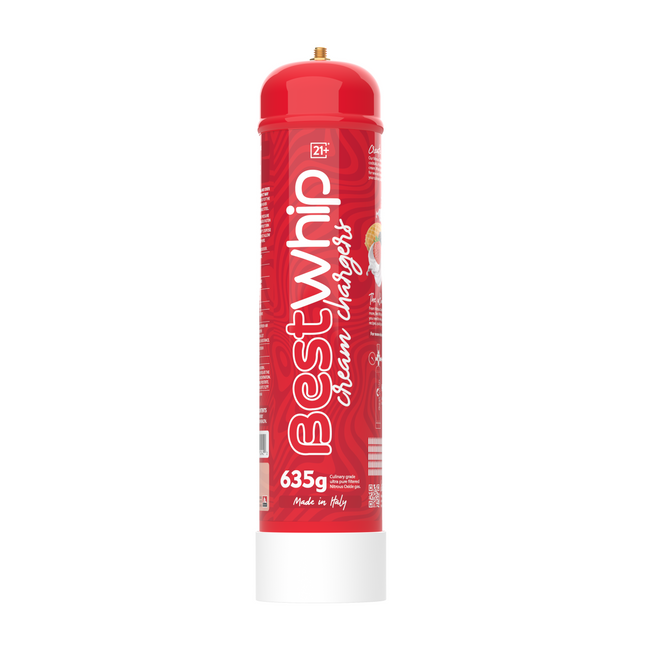
Best Whip Food-Grade Nitrous Oxide Tank 99% Pure (635g / 321 liters)
Best Whip Nitrous Oxide 635g Liquid / 1.4lbs liquid / 321 Gas Volume Liters 99% Purity / Liquid N2O This innovative cylinder is the fastest and easiest way to replenish your cream. It is not only a good assistant for making dessert at home but also a new solution for the industrial catering industry! Before using our whipped cream-making equipment you must first read the manufacturer's instructions. This will show you how to safely charge your cream using the cream 635g tank. Cylinder Fitting: M11x1 Thread (compatible with the Best Whip Nitrous Oxide Regulator.) Tank Pressure: 755 PSI Includes 1 nozzle per tank. *At end of use use this nozzle to completely empty the tank for recycling. SUPER GAS QUALITY - Each tank is filled high quality NO2. That is why you will not have a hard time making chocolate or vanilla, mint, or Bailey's flavored cream whipper. Cocktail foams, airy sauce, mousse, and hot or cold foam can be made easily, too. FOOD-GRADE & LONG SHELF LIFE - Best Whip tanks are made with food-grade compliance and production standards. Each tank has a long shelf life of 5 years so you can use them over a period of time. ANTI-LEAKAGE DESIGN - Best Whip canister conforms with Manufacturing International Standards such as ISO 9001, and ISO 9002. Any cream dispenser can be used with this cylinder. UNIVERSAL COMPATIBILITY - Compatible with all professional whipped cream makers in the market. From now on, you can easily finish making whipped cream in a few seconds and without leaving odors or contaminants in the dispenser. RECYCLEABLE CONTAINER - Made of steel construction. When you're done with it simply attach the included nozzle to discharge any remaining gas and place it in the recycling bin. What Is Nitrous Oxide? Nitrous Oxide is a chemical compound with the formula N2O. It is a colorless, non-flammable gas with a slightly sweet odor and taste. Nitrous oxide is often used for various purposes due to its unique properties and effects. What is Nitrous Oxide Used For? Nitrous oxide (N2O) is most commonly used in the culinary world for various purposes, primarily for creating foams, whipped creams, and infusions. Outside the culinary world nitrous oxide is also commonly utilized as a propellant, a cryogenic refrigerant, and as a performance-enhancing additive for internal combustion engines. Here's how nitrous oxide is most commonly used in culinary applications: Whipped Cream: Nitrous oxide is perhaps most well-known in the culinary field for its use in making whipped cream. In this application, heavy cream and sweeteners are combined in a whipped cream dispenser or siphon, and nitrous oxide cartridges are used to pressurize the dispenser. When the cream is released from the dispenser, the sudden release of pressure causes the nitrous oxide to expand and whip the cream into a light and fluffy texture. This method allows for the creation of stable whipped cream that retains its texture for an extended period. Foams: Chefs use nitrous oxide to create foams from various liquids, such as fruit juices, sauces, and purees. To make a foam, the desired liquid is mixed with a gelling agent, strained, and loaded into a whipped cream dispenser along with nitrous oxide. When dispensed, the nitrous oxide aerates the liquid, resulting in a light and airy foam that can be used as a garnish or flavor enhancer. Infusions: Nitrous oxide can be used to infuse liquids with the flavors of herbs, spices, fruits, or other aromatic ingredients. For example, herbs like basil or spices like cinnamon can be placed in a whipped cream dispenser along with a liquid (e.g., oil or alcohol) and nitrous oxide. The pressurized nitrous oxide infuses the liquid with the flavors and aromas of the added ingredients quickly. Cocktails: Some bartenders use nitrous oxide to create foam or froth on cocktails, adding a unique visual and textural element to drinks. This technique is especially popular in molecular mixology. Sauces and Dressings: Nitrous oxide can be used to create light and airy sauces or dressings. By adding nitrous oxide to a mixture of liquids and ingredients, chefs can achieve a desired texture and consistency. Desserts: Nitrous oxide can be used to create innovative desserts, such as foamy fruit purees, mousse-like textures, and light, airy soufflés. It's essential to use food-grade nitrous oxide and follow proper safety precautions when using it in culinary applications. The use of nitrous oxide cartridges and whipped cream dispensers is common in professional kitchens and home cooking to achieve these culinary effects. What Are The Hazards Of Nitrous Oxide? Nitrous oxide (N2O), while commonly used in various applications can pose certain hazards if not used properly. Here are some potential hazards associated with nitrous oxide: Asphyxiation: The most significant hazard of nitrous oxide in culinary use is the risk of asphyxiation. Nitrous oxide can displace oxygen in an enclosed space, leading to oxygen deprivation if inhaled in high concentrations. This can result in dizziness, loss of consciousness, and even death. Frostbite: Nitrous oxide is stored as a compressed liquid and is extremely cold when released. Contact with liquid nitrous oxide can cause frostbite or cold burns to the skin. Care should be taken when handling nitrous oxide cartridges or dispensers. Is Nitrous Oxide Flammable? Nitrous oxide (N2O) is not flammable in the typical sense because it does not support combustion. However, it can contribute to the combustion of other substances. Here's a more detailed explanation: Non-Flammable: Nitrous oxide itself does not burn or catch fire. It is an oxidizer, meaning it can support the combustion of other substances by providing oxygen. When nitrous oxide is used in applications like rocket propulsion or automotive nitrous systems, it does not ignite by itself. Enhancing Combustion: Nitrous oxide is sometimes used in combination with fuel in internal combustion engines to increase power output. In this context, it is often referred to as "nitrous" or "NOS." When nitrous oxide is injected into the engine's intake, it provides additional oxygen, allowing more fuel to burn, resulting in increased engine power. However, it's important to note that this process is controlled and safe when used as intended in automotive applications. Safety Precautions: While nitrous oxide is generally considered safe when used according to manufacturer guidelines, improper handling or misuse can be hazardous. Nitrous oxide should not be exposed to open flames, sparks, or high temperatures, as it can decompose at elevated temperatures and pressure, potentially leading to the release of oxygen and nitrogen gases. In summary, nitrous oxide is not flammable by itself, but it can enhance the combustion of other materials when used in controlled and purposeful applications. When using nitrous oxide, it's essential to follow safety guidelines and avoid exposing it to conditions that could lead to its decomposition or unintended ignition. How Do I Use Nitrous Oxide Safely? Using nitrous oxide (N2O) safely is crucial to prevent accidents and health risks. Here are some general guidelines for using nitrous oxide safely: Follow Manufacturer's Instructions: Always follow the manufacturer's instructions for any equipment or cartridges containing nitrous oxide. Different devices or cartridges may have specific usage guidelines. Ventilation: Ensure that you use nitrous oxide in a well-ventilated area. Adequate ventilation helps disperse any gas leaks and prevents the buildup of nitrous oxide in confined spaces, reducing the risk of asphyxiation. Avoid Direct Inhalation: Never inhale nitrous oxide directly from cartridges, whipped cream dispensers, or any other source. Inhaling nitrous oxide for recreational purposes can be dangerous and is not recommended. Protective Gear: When handling nitrous oxide cartridges or equipment, especially if they contain liquid nitrous oxide, wear appropriate protective gear, such as gloves and safety glasses, to prevent frostbite or cold burns. Store Safely: Store nitrous oxide cartridges and equipment in a cool, dry place away from direct sunlight and heat sources. Keep them out of the reach of children and unauthorized individuals. No Smoking: Avoid smoking or open flames near nitrous oxide,while nitrous oxide is not flammable, it will support combustion to the same extent as oxygen. Training and Education: Ensure that individuals using nitrous oxide equipment are trained in its safe handling and usage. Leak Detection: Regularly check for leaks in nitrous oxide equipment and connections. Use a leak detection solution (soapy water) to identify leaks by observing bubbles at the connections. Proper Disposal: Dispose of used nitrous oxide cartridges and equipment according to local regulations and guidelines. Do not puncture or incinerate cartridges. Emergency Preparedness: Be prepared for emergencies by having safety equipment, such as fire extinguishers and first-aid kits, readily available in areas where nitrous oxide is used or stored. Follow Legal Regulations: Abide by local laws and regulations regarding the sale, purchase, and use of nitrous oxide. In some areas, nitrous oxide may be subject to restrictions due to its potential for misuse. Always exercise caution and prioritize safety when using nitrous oxide, whether it's for culinary, automotive, medical, or other legitimate purposes. If you have specific concerns or questions about the safe use of nitrous oxide in a particular context, consult with experts or regulatory authorities in your area. Chemical Formula: N2O Molecular Weight: 44.013 g/mol CAS Registry Number: 10024-97-2 Appearance Colorless Odor: Characteristic Density 0.115 lb/ft3 Boiling Point: -88.5C (-127.3F) Solubility in water: Completely Soluble GHS Pictograms: GHS Signal Word: Danger GHS Hazard Statements: H270, H280, H281, H336 GHS Precautionary Statements P220, P244, P261, P271, P282, P304+P340, P319, P336+P317, P370+P376, P403, P403+P233, P405, P410+P403, P501 UN Identification Number: 1070 Proper Shipping Name: Nitrous Oxide Transport Hazard Class: 2.2, 5.1 Packing Group: None DOT Placard: Nitrous Oxide Safety Data Sheet (SDS)
$23.50 - $139.00
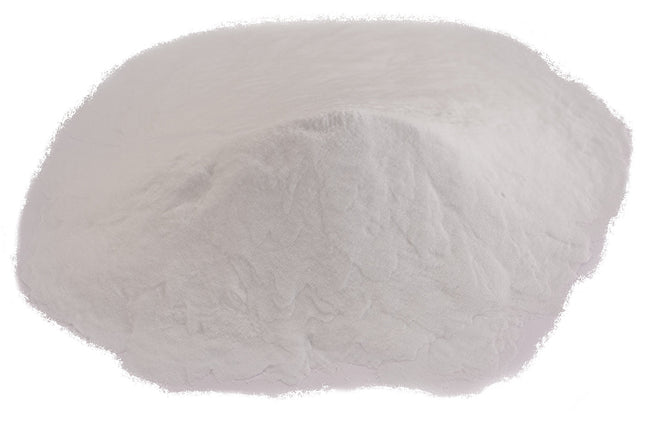
CANA-SIL60™ Silica Gel 60A Chromatographic Grade 40-63 micron (230-400 Mesh)
CANA-SIL60™ Silica Gel Silicon Dioxide 60A Chromatographic, Extraction CRC Grade Cana-Sil™ is an Optimized silica gel for extractions. This powdered silica gel (silicon dioxide) for use in chromatography batch extractions and decolorizations. Cana-Sil60 can also be used as a general adsorbent for impurities. Optimized particle size, surface area, pH, and purity make it a particularly useful material for the separation of small molecules, peptides, lipids, alkaloids, and a variety of other compounds. Silica Gel is particularly useful to use layered on top of your bentonite to remove plant gums and waxes. CANA-SIL60 Technical Data Sheet CANA-SIL60 Safety Data Sheet CANA-SIL60 Certificate of Analysis Key Specs: Particle Size: 40-63 Micron (230-400 Mesh) Pore Volume: 0.6-0.8 mL/g Loss on Drying: ≤ 2.0 wt% pH: 6.5-7.5 Empirical Formula: SiO2 Use: Chromatography Purification Hazard Statement: No ingredients are hazardous according to OSHA criteria CAS# 112926-00-8
$28.00 - $8,100.00
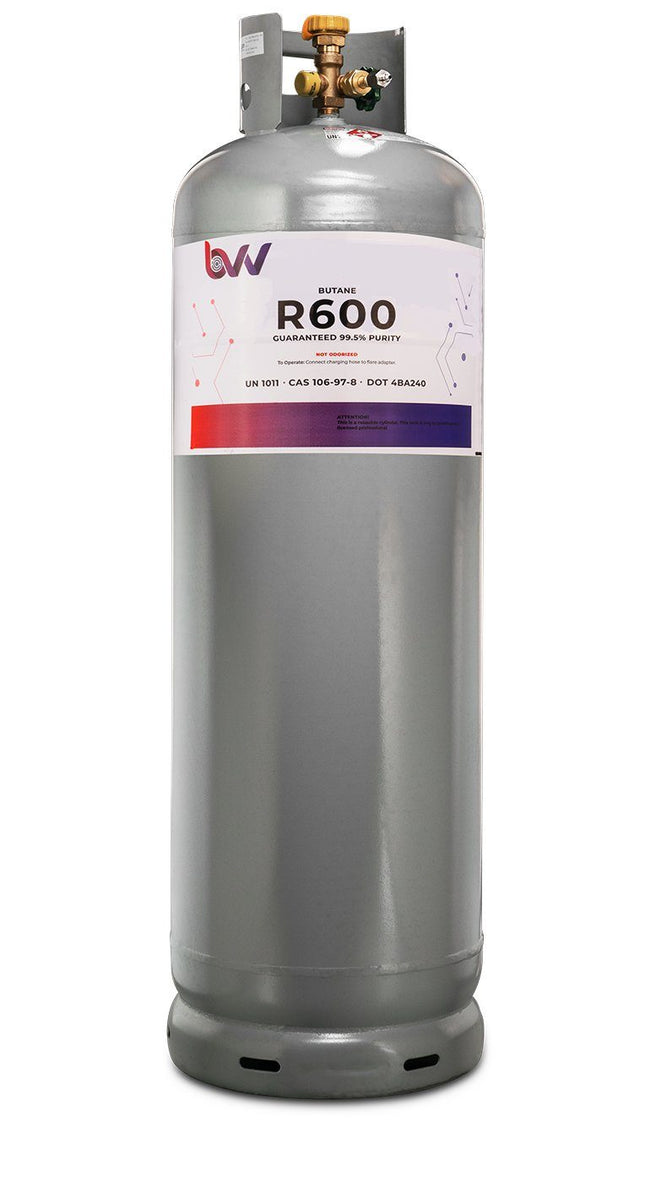
120LB DIPTUBE Tank High Purity USA N-BUTANE R600 - 99.5% Guaranteed
120LB DIPTUBE Tank High Purity USA N-BUTANE R600 DIPTUBE - 99.5% Guaranteed BVV N-butane is free of any sulfur-based mercaptan odorants, colorless, clean, and non-detectable limits* of toxic BTEX compounds which are benzene, toluene, ethylbenzene, and xylene. DISCLAIMER(S): This unit is intended for LEGAL purposes only, to be used in accordance with local laws and ordinances. Use only in WELL VENTILATED AREAS! Notice: This item will ship via Freight ONLY. BVV™ always recommends distillation of every solvent before use. Tank does not include CGA 555 fitting. Must be added through dropdown or bought separately. California now prohibits the retail sale of any Non-Odorized butane in quantities larger than 150ml. If you are not a retail purchaser you can call in to place an order. Permitted Sales Include the Following: Medical Collectives or Cooperatives operating under CA Health & Safety Code Section 11362.775 Persons licensed to perform volatile solvent extraction activity under CA Bus & Prof Code Division 10 Manufacturers, wholesalers, resellers, or retailers solely for the purpose of resale Sourced right here in the USA, this high-quality butane is guaranteed to be 99.5% pure. This is a solvent that is instrument-grade and helps produce a higher quality extract through the reduction of mystery oils and contaminants. This butane is clean, colorless, odorless, and free of any hydrogen sulfide-based ethyl mercaptan odorants. Because of this, a finer, higher quality extract is consistently available to our customers. BVV always recommends distillation of every solvent before use. Solvent comes in a DOT refillable tank. *Free of any hydrogen Sulphide based Ethyl Mercaptan Odorants. *This product is clean, colorless and odorless. Tank contains dip tube. *Actual N-butane liquid weight is 120LB Due to FAA regulations, solvent tanks cannot be safely transported via means other than ground. Any order that has solvent will not be shipped in an expedited fashion. If an order with solvent is combined with any other items and chosen to be expedited, that entire order will ship via UPS Ground/Freight. We will not split up any orders and ship them separately. If a customer is wanting to expedite specific items and order solvent, 2 separate orders (1 for the solvent and 1 for the expedited items) will need to be placed in order to do so. Solvents do not ship to Hawaii, Puerto Rico, or any other US Territory outside of the contiguous 48 States. Shipping Solvent to Alaska may ONLY ship via freight and will be required to travel through Canada. We have this policy in place to ensure safety when transporting solvents, and to prevent any issue with shipping times for our customers. Chemical Formula: C₄H₁₀ Molecular Weight: 58.12 g/mol CAS Registry Number: 106-97-8 Appearance Colorless Odor: Faint Petroleum Density 2.6 kg/m³ (or 2.6 g/L) Boiling Point: 30.2 F (-1C) Solubility in water: Low Solubility GHS Pictograms: GHS Signal Word: Danger GHS Hazard Statements: H220 GHS Precautionary Statements P203, P210, P222, P280, P377, P381, and P403 UN Identification Number: 1011 Proper Shipping Name: Butane, liquefied Transport Hazard Class: 2.1 Packing Group: None DOT Placard: N-Butane Certificate of Analysis (COA) N-Butane Safety Data Sheet (SDS)
$590.00 - $600.00
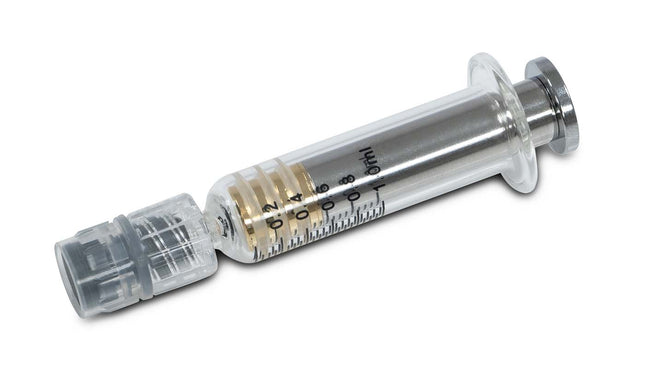
1ml Glass Dosing Syringe with Luer Lock
1ml Glass Dosing Syringe with Luer Lock This 1ml high-quality glass syringe has a triple O-ring plunger that allows for smoother dosing and Luer Lock Cap creates an airtight connection to preserve the freshness of concentrates and prevent leakage. The syringe is made from borosilicate glass, which is heat resistant, sturdy, and easy to clean! The silicone tip ensures you are sparing no oil and every last bit is dispensed.
$2.70 - $250.00
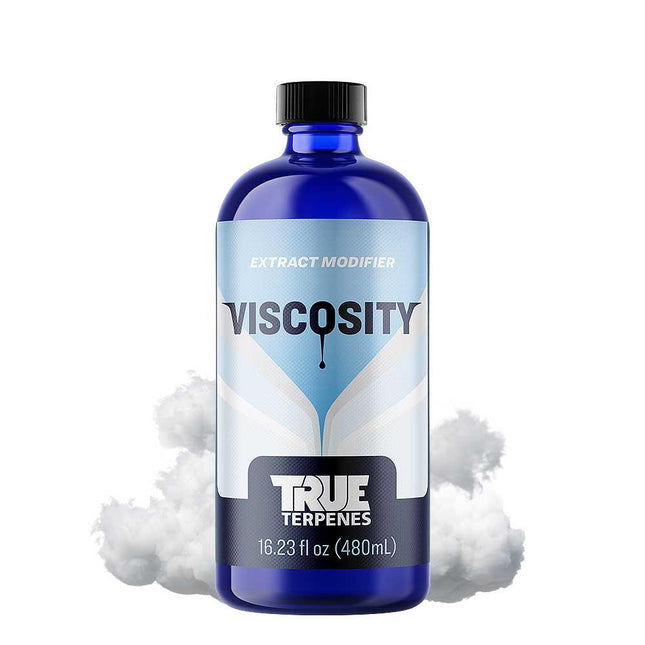
True Terpenes VISCOSITY Extract Liquifier
True Terpenes VISCOSITY Extract Liquefier All sales are final. Orders can be refunded prior to fulfillment and shipping but once the order has been fulfilled and/or shipped, no refunds will be issued. Due to the hazardous nature of our product, we are unable to accept returns. Viscosity allows you to gently control the flavor and flow rate of your premium distillates. The terpenes combine smoothly with your oil and are formulated to minimize the impact to flavor and aroma while maintaining product potency. Viscosity is not a thickening nor cutting agent and not recommended to be used with CBD. Viscosity is designed to be used with winterized extracts. Not recommended for use with BHO, Rosin, Solventless, Isolate and Raw CO2. Viscosity is the only extract modifier comprised of terpenes found natively in the plant. Viscosity allows you to gently control the flavor and flow rate of your premium distillates. The terpenes combine smoothly with your oil and are formulated to minimize the impact to flavor and aroma while maintaining product potency. Viscosity contains only terpenes: Phytol Beta-Caryophyllene D-Limonene Farnesol Nerolidol Viscosity does not include the following: No PG No VG No PEG No MCT No Squalane No Squalene No Coconut Oil No Mineral Oil No Triethyl Citrate No Vitamin E Acetate VISCOSITY Extract Liquifier is the original flavorless odorless extract diluent made from a blend of 100% organic terpenes. It does not contain PG, VG, PEG, MCT, Coconut oil, or any other non-terpene ingredients. VISCOSITY Extract Liquifier enables you to turn winterized extracts into the perfect flowing oil. VISCOSITY combines smoothly with Distilled and CO2 extracts without separation and will stay blended without additional additives, emulsifiers, or complicated processes. CERTIFICATE: COA | SDS | FOOD GRADE | NATURAL | ORGANIC TRUE GRADE™ It is our promise to you. Our isolated terpenes are triple-distilled making them the cleanest terpenes in the world. Fresh out of the bottle, undiluted, every single one of our products bests the most rigorous consumer safety standards. GMP | ISO-9001:2015 | FSSC 22000 Blended in cGMP facilities adhering to the requirements for a Quality Management System (QMS) specified by ISO 9001:2015 and FSSC 22000 standards. Analyzed Tested and passed True Grade™ safety specifications for residual solvents, pesticides and heavy metals. Stability Tested Rigorously tested with mid-grade distillate against separation, cloudiness and unacceptable levels of color change. We Qualify True Terpenes implements supply-chain control for all raw materials and is proud to provide True Terpenes’ qualification documents such as certificates, licenses and registrations to be qualified as your supplier. Undiluted We do not add PG, VG, PEG, MCT or Vitamin E Acetate to any of our products. Food Grade Manufactured in cGMP facilities using food grade ingredients. UV Protected This product is packaged in a cobalt blue, UV deterrent and food grade bottle with tamper evident seal. Made in the USA Formulated, blended, manufactured and fulfilled in the United States. Refined Isolates This product contains ultra-pure, molecularly-refined terpene isolates. Only the best.
$60.00 - $1,200.00
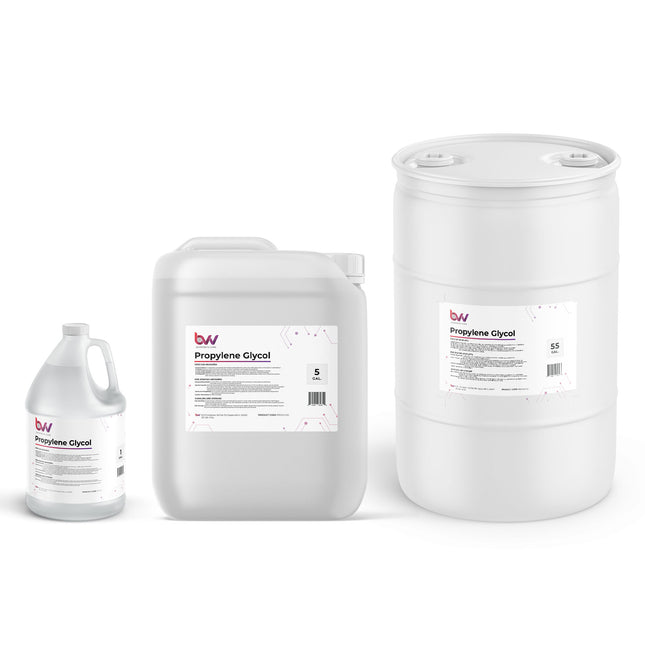
Propylene Glycol Tech Grade 100%
Propylene Glycol Disclaimer: Spigots/Faucets are only compatible with 5 Gallon Jugs and must be purchased separately BVV™ brand propylene glycol is a great heat transfer fluid alternative to water for all processing equipment such as refrigerated or heated circulators and cold traps. This propylene glycol has a freezing point of -74°F and a boiling point of 370°F. BVV™ propylene glycol is considered NOT genetically modified and NOT derived from a genetically modified organism. BVV™ Propylene Glycol SDS BVV™ Propylene Glycol Specification Sheet The expiration date is 2 years from the date of manufacture and when the glycol is kept below 100F and out of direct sunlight.
$29.00 - $4,900.00
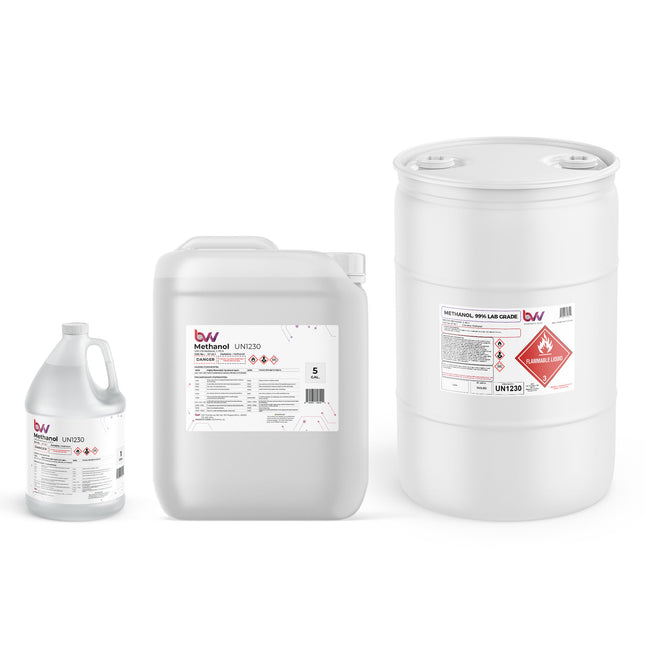
Methanol Lab Grade
High Purity Lab Grade Methanol BVV™ High Purity Lab Grade Methanol is used to remove and extract terpenes, tannins, alkaloids, glycosides, lignans, and terpinoids from plants. It is used to extract bio-active, phenolic and polar compounds from medicinal plants. Methanol is a high purity solvent used to manufacture botanical solutions and is easily evaporated. Methanol is used in research and testing laboratories for phytochemical study, phytochemical analysis and chemical synthesis. Methanol is used to prepare methanol/water/acetic acid mixtures. Chemical Formula: CH3OH Molecular Weight: 32.042 g·mol−1 CAS Registry Number: 67-56-1 Appearance Colorless Liquid Odor: Faint and similar to ethanol Density 0.792 g/cm3 Boiling Point: 64.7 °C /148.5 °F Solubility in water: Completely Soluble GHS Pictograms: GHS Signal Word: Danger GHS Hazard Statements: H225, H301, H302, H305, H311, H331, H370 GHS Precautionary Statements P210, P233, P235, P240, P241, P242, P243, P260, P264, P270, P271, P280, P301+P330+P331, P302+P352, P303+P361+P353, P304+P340, P305+P351+P338, P307+P311, P310, P311, P312, P337+P313, P361, P363, P370+P378, P403+P233, P405, P501 UN Identification Number: 1230 Proper Shipping Name: Methanol Transport Hazard Class: 3 Packing Group: II DOT Placard: What Is Methanol? Methanol, also known as methyl alcohol or wood alcohol, is a type of alcohol with the chemical formula CH3OH. It is the simplest alcohol, consisting of a methyl group (CH3) linked to a hydroxyl group (OH). Methanol is a colorless, flammable liquid with a slightly sweet odor. It is commonly used as an industrial solvent, antifreeze, fuel, and as a feedstock in the production of chemicals, plastics, and synthetic materials. Methanol can be synthesized from various sources, including natural gas, carbon monoxide, and biomass. It is considered a hazardous substance due to its toxicity when ingested, inhaled, or absorbed through the skin. Methanol is also used as an industrial and laboratory solvent and as a fuel in some types of racing cars and model engines. One important thing to note is that methanol is highly toxic when consumed, and even small amounts can be lethal. It should never be ingested, and safety precautions should be taken when handling this substance. What Is Methanol Used For? Methanol is used for a wide range of industrial, commercial, and laboratory applications. Some of its common uses include: Fuel: Methanol is used as an alternative fuel in some types of vehicles, particularly racing cars and model engines. It is also used in the production of biodiesel and as a fuel additive. Solvent: Methanol is a versatile solvent that can dissolve a variety of substances, making it useful in industries such as paint, varnish, and ink production. It is also used as a cleaning agent in laboratories and industrial settings. Antifreeze: Methanol is an essential component of some antifreeze formulations, where it helps prevent the freezing of engine coolant in cold temperatures. Chemical Intermediate: Methanol serves as a key building block in the production of various chemicals and materials, including formaldehyde, acetic acid, methyl methacrylate (used in plastics and coatings), and more. Fuel Cell Feedstock: Methanol can be used as a feedstock for the production of hydrogen, which can be used in fuel cells for electricity generation and other applications. Preservative: In the pharmaceutical and personal care industries, methanol is used as a preservative in some products. Denaturant: Methanol is added to industrial ethanol to make it unfit for consumption (denatured). This ensures that the ethanol cannot be used for drinking purposes and is used for industrial applications. Laboratory Reagent: Methanol is commonly used in laboratories as a reagent and solvent for various chemical experiments and analyses. Extraction: It is used in some extraction processes, such as the extraction of essential oils from plants. Energy Storage: Methanol is being explored as a potential energy carrier for energy storage and transportation, particularly in the form of methanol fuel cells. It's important to note that methanol is toxic to humans and should be handled with care. Ingesting or inhaling methanol vapors can be extremely dangerous and potentially fatal. Proper safety precautions and handling procedures are necessary when working with methanol. What Is The Structure of Methanol? Methanol, also known as methyl alcohol, has a simple chemical structure. Its molecular formula is CH3OH, which represents one carbon (C) atom, four hydrogen (H) atoms, and one oxygen (O) atom bonded together. Here's the structural formula of methanol: In this structure: The central carbon atom (C) is bonded to three hydrogen atoms (H) and one oxygen atom (O). The oxygen atom is bonded to the carbon atom through a single covalent bond (C-O). The remaining three hydrogen atoms are bonded to the carbon atom, completing its four covalent bonds. Methanol is a polar molecule due to the electronegativity difference between oxygen and hydrogen atoms, which results in a partial positive charge on the hydrogen atoms and a partial negative charge on the oxygen atom. This polarity gives methanol its unique chemical properties and makes it a versatile solvent in various applications. What are the Hazards of Methanol? Methanol, while commonly used in various industrial and laboratory applications, poses several hazards, primarily due to its toxic and flammable nature. Here are some of the hazards associated with methanol: Toxicity: Methanol is highly toxic to humans when ingested, inhaled, or absorbed through the skin. The toxic effects are primarily due to its metabolites, formaldehyde, and formic acid. Methanol poisoning can lead to symptoms such as headache, dizziness, nausea, vomiting, abdominal pain, and in severe cases, it can cause blindness, organ failure, and death. Flammability: Methanol is flammable and can form explosive mixtures in the air when its vapor concentration is within certain limits. It has a relatively low flashpoint, making it susceptible to ignition by heat, sparks, or open flames. Proper storage and handling precautions are essential to prevent fire hazards. Irritant: Methanol can be irritating to the eyes, skin, and respiratory tract. Contact with methanol vapor or liquid can lead to skin irritation, redness, and chemical burns. Inhaling methanol vapor can irritate the respiratory system and cause coughing and throat irritation. Environmental Impact: Methanol is harmful to the environment. Spills or releases of methanol can contaminate soil and water, posing a risk to aquatic life and ecosystems. It is important to handle and dispose of methanol responsibly to minimize its environmental impact. Incompatibility: Methanol should not be stored or transported in containers or systems that have previously held incompatible materials, as it can react with some substances and form hazardous compounds. Cumulative Exposure: Prolonged or repeated exposure to methanol vapor or mist over time can result in cumulative health effects, particularly on the central nervous system and the optic nerve. Ingestion Risk: Methanol has a sweet taste and is sometimes mistaken for ethanol (the alcohol found in alcoholic beverages). Accidental ingestion of methanol can occur, especially if it is stored in containers that are not clearly labeled. To safely handle methanol and mitigate these hazards, it is crucial to follow strict safety protocols, use appropriate personal protective equipment (PPE), store methanol in well-ventilated areas away from open flames, and provide proper training to personnel working with methanol. Emergency response plans and first-aid measures for methanol exposure should also be in place in case of accidents or spills. How Do I Use Methanol Safely? Using methanol safely is essential due to its toxic and flammable nature. Whether you're working with methanol in a laboratory, industrial setting, or other applications, here are some guidelines for safe handling: Personal Protective Equipment (PPE): Always wear appropriate PPE, including safety goggles, chemical-resistant gloves, a lab coat or chemical-resistant apron, and closed-toe shoes. Consider additional protective gear, such as a face shield, when handling large quantities or performing high-risk operations. Storage: Store methanol in well-ventilated areas away from heat sources, open flames, and direct sunlight. Use containers made of materials compatible with methanol, such as glass or approved plastic containers. Label containers clearly with the contents. Ensure proper labeling and hazard signage in storage areas. Handling: Handle methanol in a fume hood or well-ventilated workspace to minimize inhalation exposure. Do not use methanol near open flames, sparks, or heat sources. Avoid skin contact; wear gloves and lab coats to prevent skin exposure. Use a face shield or safety goggles to protect your eyes. Spill Response: Have spill kits and absorbent materials (e.g., spill pads, spill pillows) available for immediate use. In the event of a spill, ventilate the area, and contain the spill to prevent it from spreading. Wear appropriate PPE when cleaning up spills. Follow your workplace's spill response procedures and dispose of contaminated materials properly. Storage and Dispensing: Use safety containers designed for methanol when dispensing or transferring the liquid. Never use glassware or containers that have been used for other chemicals without thorough cleaning. Ensure proper grounding and bonding when transferring methanol to prevent static electricity buildup. Inhalation Exposure: Minimize inhalation exposure by working in a well-ventilated area or under a fume hood. If you suspect inhalation exposure, move to an area with fresh air and seek medical attention if symptoms persist. Ingestion Prevention: Do not eat, drink, or smoke in areas where methanol is handled. Avoid using containers or equipment that may be contaminated with methanol for food or beverage storage. Fire Safety: Methanol is flammable; keep it away from open flames, sparks, and heat sources. Use explosion-proof electrical equipment in areas where methanol vapors may be present. Emergency Response: Familiarize yourself with the location of safety showers, eyewash stations, fire extinguishers, and emergency exits. Know the location of first-aid supplies and procedures for methanol exposure. Training and Education: Ensure that personnel handling methanol are properly trained in its safe handling, storage, and emergency response procedures. Waste Disposal: Dispose of methanol waste in accordance with local, state, and federal regulations for hazardous waste disposal. Always follow your workplace's safety protocols and consult with safety officers or supervisors for specific safety procedures related to methanol handling in your environment. Regular safety training and awareness are essential to prevent accidents and protect your health when working with methanol. Methanol Safety Data Sheet (SDS) Methanol Certificate of Analysis (COA)
$12.00 - $1,100.00
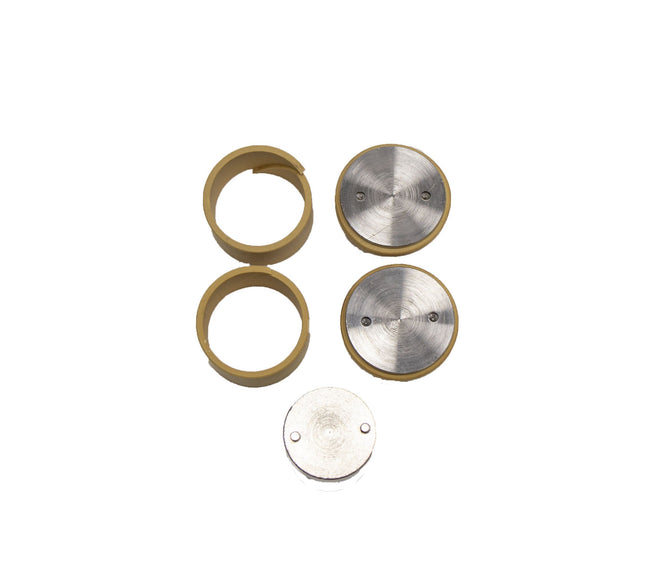
TRS21 / BVV Upgraded Top Piston Assembly
BVV-3 Included in this kit: Top piston assembly with piston seal and piston wear band. This upgrade kit can be used for the following recovery pumps: CPS TRS21 Anti-spark/explosion pump BVV 2 Cylinder Butane Recovery Pump ITS/ETL to ANSI/ISA Certified BVV 4 Cylinder Butane Recovery Pump ITS/ETL to ANSI/ISA Certified - Requires 2 kits because this unit has 4 cylinders. BVV CMEP-OL Retro Fit Upgraded Head - Requires 2 kits because this unit has 4 cylinders. BVV 4 Cyl & 2 Cyl Pump Seal Rebuild Instructions If you have upgraded to the 2-piece SS piston design this kit is used to rebuild the piston seal and wear band. Piston tool (SKU: BVV-TL1) and Loctite 242 will be needed to properly install. If tool is not used the customer is responsible for any damage done to piston during assembly.
$110.00
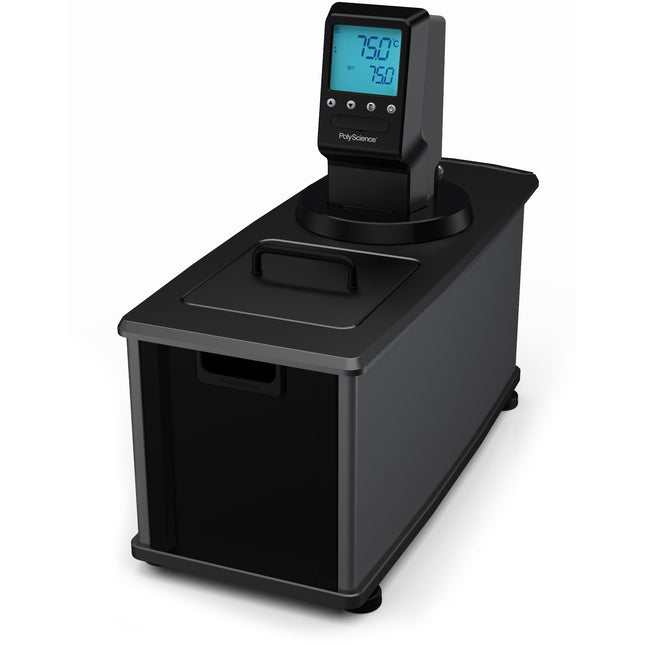
Polyscience 7 Liter MX Heated Circulator
Polyscience 7 Liter MX Heated Circulator Key Specifications Description 135, 7 L Htg. Circulator Controller Type MX Display 3.25" LCD Languages Supported English Temperature Stability °C Ambient +10° to 135° Temperature Stability °C ±0.07° Temperature Calibration Capability 1-point Working Access (L x W x D) (cm) 15.7 x 14.2 x 12.7 cm Pump Type Pressure Flammability Class (DIN 12876-1) I (NFL) Working Temperature Range °F Ambient + 20° to 275° Working Temperature Range °C Ambient +10° to 135° Reservoir Capacity (gallons) 1.85 Reservoir Capacity (liters) 7 Reservoir/Tank Material Stainless Steel Reservoir Cover Included DuraTop Yes LidDock Yes Working Access (L x W x D) (inches) 6.18 x 5.59 x 5 in Working Access (L x W x D) (cm) 15.7 x 14.2 x 12.7 cm Temperature Stability °F ±0.13° Temperature Stability °C ±0.07° Display 3.25" LCD Display Resolution (Set) 0.1 Display Resolution (Read) 0.1 Pump Type Pressure Pump Speed One Process Connections 1/2" O.D. Barbed Tubes Flammability Class (DIN 12876-1) I (NFL) Over-Temperature Protection / Failsafe Heater Control Yes Low Liquid Level Protection Yes Reservoir Drain Yes Cooling Coil Yes Maximum Ambient Temperature °F 95° Maximum Ambient Temperature °C 35° Overall Dimensions (L x W x H) (inches) 19.6 x 8.7 x 17.2 in Overall Dimensions (L x W x H) (cm) 49.9 x 22.1 x 43.7 cm Environmental Compliance RoHS, WEEE Shipping Weight (pounds) 36.0 Shipping Weight (kilograms) 16.3 Catalog Page Number 60-61 60 Hz Only Part Number MX07H135-A11B Maximum Pressure (psi) 2.3 Maximum Pressure (bar) 0.16 Maximum Pressure Flow Rate (gpm) 3.60 Maximum Pressure Flow Rate (l/min) 13.5 Included Hardware Fitting Kit for External Applications Heater Wattage 1100 Electrical Requirements (VAC/Hz/Ph/A) 120/60/1/10 Regulatory Approvals ETL Key features: Large, universal icon and English display On-screen prompts Single-point calibration capability Certifications Regulator Approvals: ETL Operator's Manual
$2,300.00
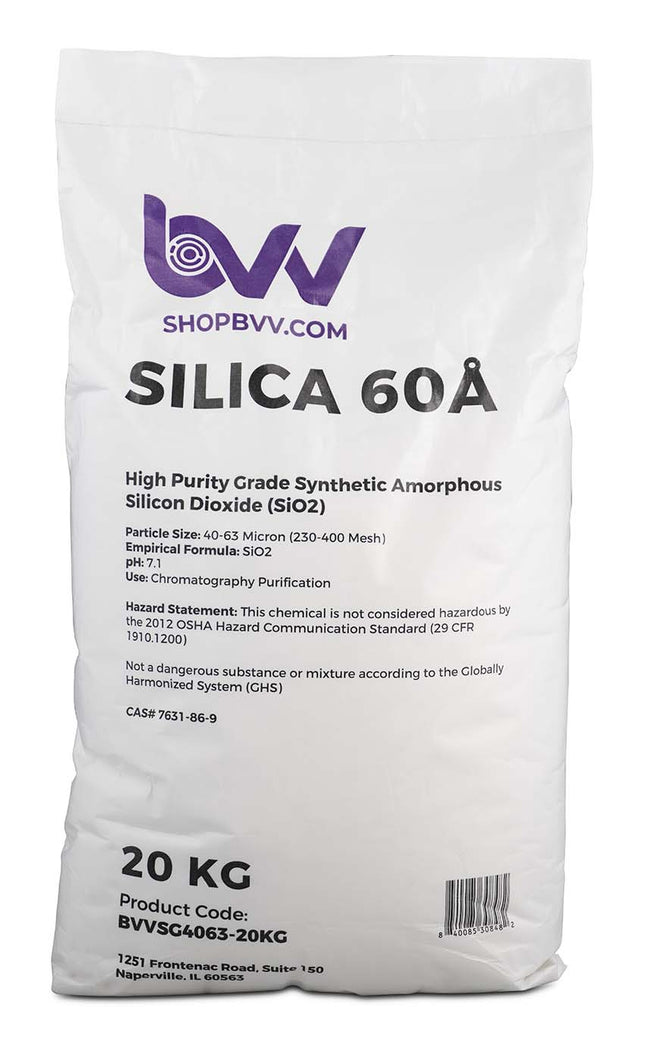
Silica Gel 60A 40-63 Micron CRC Grade
60A (40-63 Micron) Silica Gel High Purity Extraction CRC Grade The house brand Silica Gel is optimized for Color Remediation extractions. This powdered silica gel is for use in batch extractions and decolorizations. It can also be used as a general adsorbent for impurities. Optimized particle size, surface area, pH, and purity make it a particularly useful material for the separation of small molecules, peptides, lipids, alkaloids, and a variety of other compounds. Silica Gel is particularly useful to use layered on top of your bentonite to remove plant gums and waxes. BVVSG4063 Technical Data Sheet BVVSG4063 Certificate of Analysis BVVSG4063 Safety Data Sheet Key Specs: Particle Size: 40-63 Micron (230-400 Mesh) Pore Volume: 0.72 mL/g Loss on Drying: ≤ 2.0 wt% pH: 7.1 Empirical Formula: SiO2 Use: Decolorization Hazard Statement: No ingredients are hazardous according to OSHA criteria CAS# 7631-86-9
$420.00 - $8,300.00
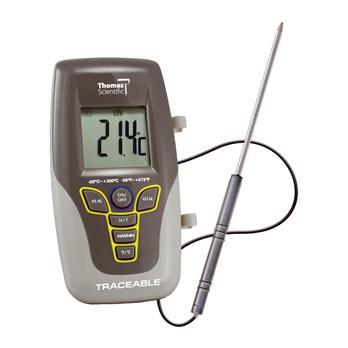
Traceable Kangaroo Thermometer - Digital
Digital Thermometer Traceable Kangaroo™ Thermometer comes equipped with the 42-inch probe cable in a reel-compartment pouch in the back of the unit. As a perfect “carry-around” unit, this thermometer can fit easily in any pocket, or you can use the convenient flip-open stand to place upright. The dual-range digital thermometer measures temperature in test tubes, beakers, and other scientific laboratory equipment and is especially effective for rugged applications with high-impact ABS cases. Additionally, digital thermometers can measure the temperature of many substances from air to liquids to surfaces—all electronically. The best thing about this thermometer? It’s easy to use! Any user can record identical results with this intuitive unit. The range is –58.0 to 572°F and –50.0 to 300°C with a resolution of 0.1° (between –19.9 to 199.9°) otherwise 1° and an accuracy of ±1°C (between –30 and 250°C) otherwise ±2°C. This unit automatically captures and recalls minimum and maximum temperature readings over any time period. Its high and low alarm may be programmed in 1° increments. The alarm sounds every minute until temperature returns to non-alarm condition. Pressing the HOLD key freezes the display to record a current reading. To assure accuracy, an individually serial-numbered Traceable® Certificate is provided from its ISO 17025 calibration laboratory accredited by A2LA. It indicates traceability to standards provided by NIST (National Institute of Standards and Technology). The stainless-steel probe has a diameter of 0.14 inches x 7-1/2 inch length and is resistant to most chemicals. The supplied silver-oxide battery runs continuously for one year. Large 3/4-inch digits are readable from 20 feet. Compact size is 2-1/2 x 4-3/4 x 1/2 inches, and weight is 2-3/4 ounces. Each product goes through an intense vetting process before carrying the Traceable name, which means you’ll save both time and money by not having to calibrate separately. The Traceable Kangaroo Thermometer applies to various unique applications such as the storage, laboratory, and medical industries. Specifications: Temperature Range F: -58 - 572F Temperature Range C: -50 - 300C Temperature Resolution: 0.1C Temperature Accuracy: +/-1C Programmable High and Low Alarm ISO 17025 Calibration Stainless Steel Probe Diameter of Probe: 0.14 in Length of Probe: 7.5 in Size: 2.5x4.75x.5 in Weight: 2.75 ounces
$60.00
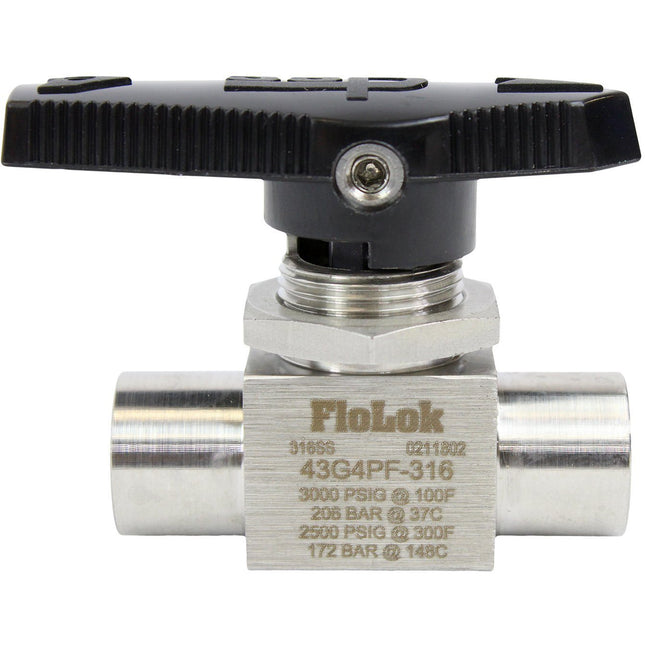
2 Way Ball Valve - Female NPT
2 Way Ball Valve - Female NPT SSP Instrumentation Flolok® manually operated two-way ball valves provide quick ¼ turn directional flow control of fluids in instrumentation and process systems. Features: Directional handle indicates flow direction Panel Mountable 90-degree actuation Straight through flow path Micro finished ball provides a positive seal Free-floating ball design provides compensation for seat wear for repetitive sealing Blow-out proof ball & stem Standard Product Testing - Every ball valve is assembled and tested @ 1000 psig (68.9 bar) with Nitrogen Specifications Body Material 316 Stainless Steel Temp Rating -53C to 148C Pressure Rating @100F 3000 PSIG @37C 208 BAR @300F 2500 PSIG @148C 172 BAR Connection Type 1 Female NPT Connection Size 1 Specified by User Connection Type 2 Female NPT Connection Size 2 Specified by User Handle Type Nylon-Stainless Steel Insert Handle Color Black Packing Material PTFE SSP proudly makes Duolok®, TruFit®, FloLok® and hundreds of other products 100% in the USA!
$110.00 - $230.00
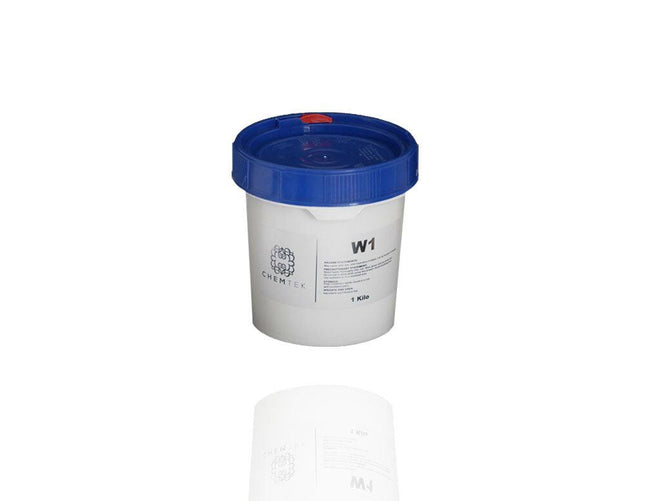
CHEMTEK W1 Acid Activated Refinement Clay
Chemtek W1 W1 (TM) is an acid activated bentonite clay adsorbent specific for the removal of chlorophyll, heavy metals, and fats. W1 is very effective at bleaching and refining while preserving the terpenes present in the oil. Unlike other clays, the ability to remove soaps and free fatty acids which are produced during the bleaching process reduces the amount of clay needed to bleach. W1 SDS W1 Technical Data Sheet
$50.00 - $2,250.00
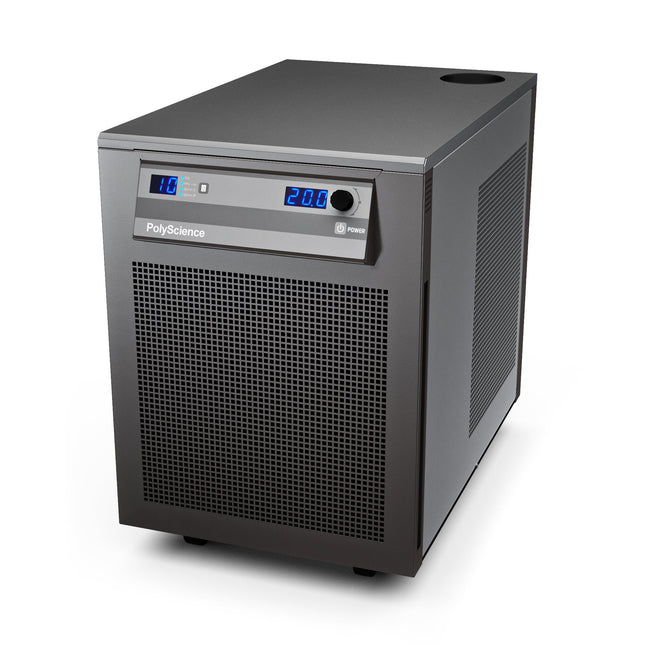
Polyscience DuraChill 1.5HP Chiller, Turbine Pump
Polyscience DuraChill 1.5HP Chiller, Turbine Pump Note: This item has a lead time of 2-3 weeks depending on stock availability Specification Description 1.5 HP Chiller, Turbine Pump; Air-Cooled Display LED Connectivity Optional: RS232, RS485 Working Temperature Range °C 5° to 35° Temperature Stability °C ±0.5° Temperature Calibration Capability 1-point Pump Type Turbine Working Temperature Range °F 41° to 95° Working Temperature Range °C 5° to 35° Reservoir Capacity (gallons) 3.5 Reservoir Capacity (liters) 13.25 Reservoir/Tank Material Polyethylene Reservoir Cover Screw-on Cap Cleanable Air Filter Yes Cleanable Fluid Filter Yes Temperature Stability °F ±0.9° Temperature Stability °C ±0.5° Display LED Display Resolution (Read) 0.01 Pump Type Turbine Process Connections 1/2" (F) NPT Over-Temperature Protection / Failsafe Heater Control Yes Reservoir Liquid Level Indicator Yes Reservoir Drain Yes Maximum Ambient Temperature °F 95° Maximum Ambient Temperature °C 35° Overall Dimensions (L x W x H) (inches) 30.5 x 19 x 26 in Overall Dimensions (L x W x H) (cm) 78 x 48 x 66 cm Compressor Size (HP) 1.5 Refrigerant R134a Shipping Weight (pounds) 340.0 Shipping Weight (kilograms) 154.0 Catalog Page Number 104 60 Hz Only Part Number 6860T56A270D Maximum Pressure (psi) 100.0 Maximum Pressure (bar) 6.90 Maximum Pressure Flow Rate (gpm) 11.00 Maximum Pressure Flow Rate (l/min) 41.6 Cooling Capacity @ +10°C (W) 4420 Cooling Capacity @ 0°C (W) 120 Cooling Capacity @ +20°C (W) 5200 Cooling Capacity @ +30°C (W) 5980 Heater Wattage 1000 Electrical Requirements (VAC/Hz/Ph/A) 230/60/1/23.1 Regulatory Approvals TUV Key specifications: High capacity cooling for lasers, electron microscopes, and other laboratory applications Small footprint conserves floor space Displays temperature and pressure or flow rate simultaneously User-adjustable temperature, pressure, and flow rate alarms Simple operation and maintenance Air- or water-cooled Positive displacement (PD) or turbine (T) pump; other pump options also available Certifications Regulatory Approvals: TUV Operator's Manual
$11,431.00

BVV Wood Stabilizing Resin PC504/66
Wood Stabilizing Resin with Activator (Heated Cured) Commercial Grade heat cured resin designed to penetrate and harden soft porous materials for smooth turning Disclaimer: Activator comes separated from resin wood stabilizer. It is intended for stabilization of wood products and is not intended for human consumption. Note: Spigots/Faucets are only compatible with 5 Gallon Jugs and must be purchased separately Note: This product is compatible with Cactus Juice and can be blended. Precautionary Statement: Store at temperatures not exceeding 20°C /68°F Wood Stabilizing Resin SDS Wood Stabilizing Resin TDS Wood Stabilizing Resin Instructions Aerospace approved heat-cured resin for stabilizing and hardening the wood and other porous material. This resin is reusable and does not significantly change the color of most woods. Prior to first use or after an extended period of storage, entire contents should be de-gassed by subjecting contents to a vacuum of at least 25 inches of mercury for 30 minutes. Wood Stabilizer will cure when exposed to 194°F (90°C) for at least 10 minutes. Therefore the time required to completely cure a stabilized blank will depend on factors such as wood thickness and density. Wood Stabilizer is compatible with many dyes and stains. However, BVV™ makes no guarantee or warranty that Wood Stabilizing Resin is compatible with all dyes and stains and will not be liable for any loss due to incompatibility. It is recommended to test compatibility on a small sample first to reduce risk of loss of wood or stabilizer
$80.00
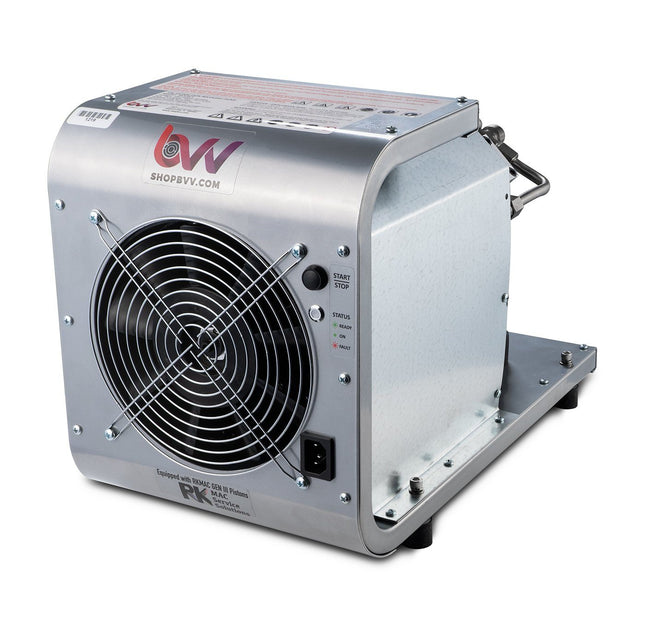
BVV 4 Cylinder Butane Recovery Pump - Meets ANSI 12.12.01
Butane Recovery Pump RECOVER MORE WITH LESS BVV is proud to introduce our new and powerful line-up of Butane & Propane Recovery Pumps. Blending compact design with improved Gen III Pistons from RKMAC, this collection of pumps can help you recover 1lb. Butane / 0:51 Seconds! This pump Assembled in the USA and all the critical parts are domestically made. Finding parts won't be an issue with this pump. The piston seals are rated to 450F and the average operating temperature of the pump is 175F leading to a long service life. Built to meet ANSI/ISA 12.12.01 for Use in Hazardous locations Class I & II, Division 2 and Class III, Divisions 1 & 2 environments. The computer controlled brushless DC motor operates at 3000 RMP nearly twice as fast as any other pump in its class. BVV Butane & Propane Recovery Pump Features: Process up to hundreds of pounds of vapor recovery before rebuild Equipped with oil-less reciprocating compressors for a clean product Designed and Assembled in the U.S.A. with domestic and global parts Affordable and highly cost efficient Available in 2-Cylinder, 4-Cylinder, CMEP Retrofit Comes with a 1-year Manufacturer’s Warranty covering Hemp usage Rated universal voltage 100-240V AC 50/60 Hz 1Ph Built with high efficiency Brushless DC Motor used for variable speed control Equipped with Viton O-Ring Seals for Butane/Propane gas and oil compatibility Piston Seal rebuild kits are USA made and available Part# BVV-3. Certified by ITS/ETL to ANSI/ISA 12.12.01 Noise level: 93.0 dB @ 1m Technical Data Sheet Product Brochure BVV™ 2 & 4 Cylinder Rebuild Instruction Manual Shop all recovery pumps here. *Butane recovery results were achieved on a collection base pressure greater than 30psi and using a recovery cylinder with a pressure <10psi. A dry ice coil was used in between the output port of the pump and the recovery cylinder to condense vapor.
$2,150.00
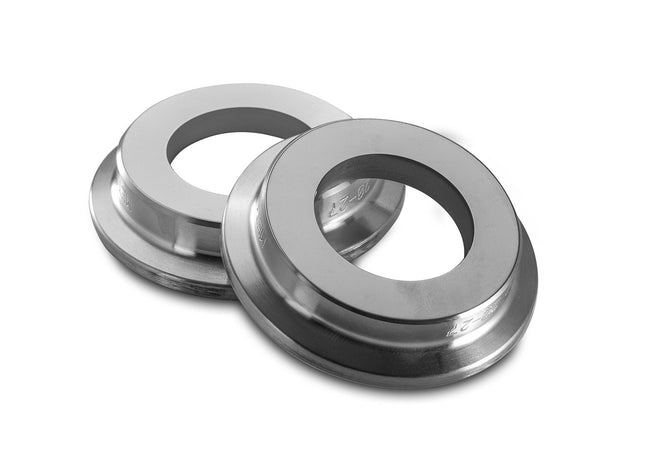
METAGLAS® Tri-Clamp Sight Glass
METAGLAS Tri-Clamp/ Tri Clover Sight Glass ***NOTICE TO CUSTOMER: ONLY CONTAINS 1 SIGHT GLASS. Please increase quantity if you want more.*** Data Sheet Metaglas Line Operating and Maintenance Instructions The strongest, most secure sight glass available, Metaglas mechanically prestressed windows, are available in a sanitary clamp design, MetaClamp, for ports and light ports in processing applications or inline visual flow indicators. Application: Sanitary MetaClamps to fit sanitary clamp connections. With simple and fast installation with no risk of breakage, this sleek, compact, one-piece design provides a cleaner look, less bateria traps and unsurpassed safety. The MetaClamp sight glass can be used as a view port mounted on a ferrule, a “cross” for inline visual flow indication or as a light port. Many other connection types are also available, as shown on the reverse side. Materials available include 2205 Duplex Stainless Steel, Hastelloy®, Monel® and Inconel®. Approvals and Technical Data: - USP Class VI (tested to confirm biocompatibility) - BPE Compliant and TÜV Approved - Sight glass fused to metal conforming to DIN7079 - Borosilicate glass to USP Type I and DIN7080 - Standard surface finish of 10 Ra µ-in (0.25µm) - Material to ASTM/ASME, TÜV and DIN/EN standards - Certificate of Conformity to EN 10204-3.1B or 3.1A - Pressure Equipment Directive 97/23/EG How Metaglas® Works: Metaglas provides a level of safety and a useful service life, well beyond that provided by conventional tempered glass or plastic used as sight glass windows. Even in the most extreme temperature (to 572ºF using Hastelloy) or overpressure situations, sudden, total failure essentially never occurs. Patented Metaglas windows are formed by melting borosilicate glass into a precisely formed metal ring. As the glass cools, it solidifies, preventing the metal ring from contracting back to its theoretical size. The result is a uniform, mechanically prestressed fusion of glass and metal that combines excellent optical characteristics with greatly enhanced physical characteristics. Vital in sanitary service, the Metaglas discs have an uninterrupted surface with no crevice to trap bacteria - no epoxies, resins, or glue - a true fusion. The standard surface finish is 10 Ra µ-in (0.25 Ra µm). Electopolishing available upon request.
$460.00 - $485.00
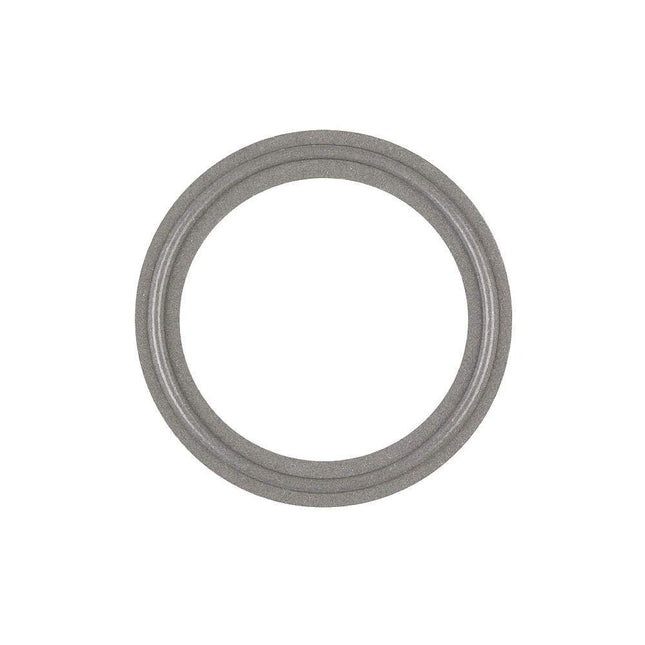
Rubber Fab Tuf-Steel 316L Tri-Clamp Style Gaskets Type I
Rubber Fab Tuf-Steel 316L Tri-Clamp Style Gaskets Type Tuf-Steel is composed of a unique 50/50 blend of nonpigmented PTFE and 316L passivated and atomized stainless Steel° Testing and seven years of documented application usage has demonstrated that Tuf-Steel is the choice for perfect surface performance, outstanding durability and extended service life in both SIP (steam in place) and WFI (water for injection) applications. Tuf-Steel® is ideal for sanitary steam pipe connections in extreme temperatures ranging from -320°F to 550°F. The superior strength of Tuf-Steel® eliminates creep and cold flow providing a leak-free seal and preventing maintenance problems and system downtime. 500 CIP/SIP Cycles guaranteed -325°F to 550°F Superior creep resistance Excellent expansion/contraction stability with minimal thermal expansion Excellent chemical resistance Stops leaks when correctly torqued (50 in./lbs with Torque-Rite® TR-50) No gasket extrusion into the sanitary tube I.D. No obstruction of flow Maintains sealing stability in T processes Non-stick surface Non pigmented Passivated to eliminate rouging Rubber Fab's Type I gaskets are: FDA CFR 177.2600 FDA CFR 177.1550 U.S. Pharmacopeia Class VI Certification ADI Free (Animal Derived Ingredient Free) certified Manufactured according to cGMP Guidelines Sizes Available: 1/2 in. 3/4 in. 1 in. 1 1/2 in. 2 in. 2 1/2 in 3 in. 3 1/2 4 in
$9.50 - $297.00
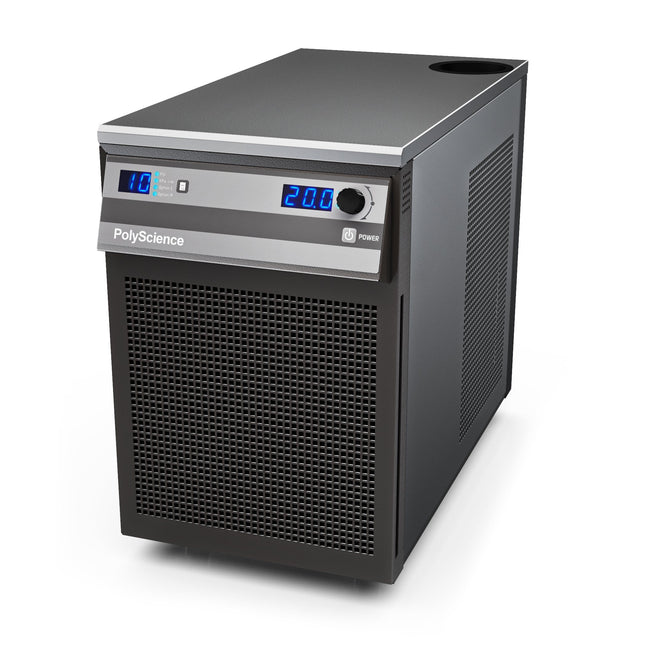
Polyscience 6100 Series 1 HP Chiller, Turbine Pump
Polyscience 6100 Series 1 HP Chiller, Turbine Pump Key Specifications: 6100 Series 1 HP Chiller with Turbine Pump, 100psi; 13.2l/min Display: LED Working Temperature Range C: -10 to 40 Temperature Stability: +/-0.1 Temperature Calibration Capability: 1-point Pump Type: Turbine Key Features: Large, dual displays present temperature and pressure or flow rate simultaneously Compact, portable design takes up less floor space Cooling at ambient temperatures as high as 35C Powerful Turbine Pump User-adjusable temperature, pressure, and flow rate alarms Cool Command, WhisperCool Common Specifications: Working Temperature Range F: 14 to 104 Working Temperature Range C: -10 to 40 Reservoir Capacity (gallons): 1.11 Reservoir Capcity (liters): 4.2 Reservoir Cover: Screw-on cap Cleanable Air Filter: Yes Cleanable Fluid Filter: Yes Temperature Stability F: +/-0.2 Temperature Stability C: +/-0.1 Display: LED Dispplay Resolution (Read): 0.1 Pump Type: Turbine Process Connections: 1/2" FNPT Over-Temperature Protection / Failsafe Heater Control: Yes Reservoir Liquid Level Indicator: Yes Reservoir Drain: Yes Cool Command Refrigeration Technology: Yes WhisperCool Environmental Control Techonology: Yes Maximum Ambient Temperature F: 95 Maximum Ambient Tmeperature C: 35 Overall Dimensions (LxWxH inches): 27.6 x 14.5 x 22.6 Overall Dimensions (LxWxH cm): 70 x 36.8 x 57.5 Compressor Size (HP): 1 Refrigerant: R134a Shipping Weight (pounds): 199 Shipping Weight (kilograms): 90 60 Hz Only Part Number: 6160T21A130D Maximum Pressure (psi): 100 Maximum Pressure (bar): 6.90 Maximum Pressure Flow Rate (gpm): 3.50 Maximum Pressure Flow Rate (l/min): 13.2 Cooling Capacity @ +10C(W): 1925 Cooling Capacity @ +20C(W): 2900 Cooling Capacity @ +30C(W): 3103 Electrical Requirements (VAC/Hz/Ph/A): 230/60/1/12.2 Certifications Regulatory Approvals: TUV
$7,900.00
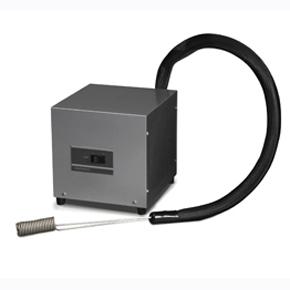
Polyscience IP-60 Low Temperature Cooler, 1.5" Rigid Coil Probe
Polyscience IP-60 Low Temperature Cooler, 1.5" Rigid Coil Probe ***Note: This item has a possible lead time of 2-3 weeks depending on stock availability.*** Specification Description Immerson Probe-60, 1.5" Rigid Coil Working Temperature Range °C -60° to -20° Temperature Control (°C) Fixed at -60° Working Temperature Range °F -76° to -4° Working Temperature Range °C -60° to -20° Temperature Control (°F) Fixed at -76° Temperature Control (°C) Fixed at -60° Maximum Ambient Temperature °F 86° Maximum Ambient Temperature °C 30° Overall Dimensions (L x W x H) (inches) 11 x 10 x 9 in Overall Dimensions (L x W x H) (cm) 27.9 x 25.4 x 22.9 cm Refrigerant R404A & R508B Immersion Probe Type Rigid Coil Probe Diameter (inches) 1.5 Probe Diameter (cm) 3.81 Probe Length (inches) Coil: 4 / Exposed: 15 Probe Length (cm) Coil: 10.2 / Exposed: 38.1 Flexible Hose Diameter (inches) 1.5 Flexible Hose Diameter (cm) 3.81 Flexible Hose Length (feet) 4 Flexible Hose Length (m) 1.22 Shipping Weight (pounds) 49.0 Shipping Weight (kilograms) 22.0 Catalog Page Number 114-115 60 Hz Only Part Number P60N2A101B Cooling Capacity @ -60°C (W) 0 Cooling Capacity @ -40°C (W) 100 Cooling Capacity @ -30°C (W) 125 Cooling Capacity @ -20°C (W) 150 Electrical Requirements (VAC/Hz/Ph/A) 120/60/1/5 Key Features: Continuous cooling to temperatures as low as -60C Designed to run at maximum cooling An economic alternative to dry ice or liquid nitrogen Excellent for trapping applications, freeze drying, and rapidly cooling small volumes of liquids Operator's Manual
$2,350.00
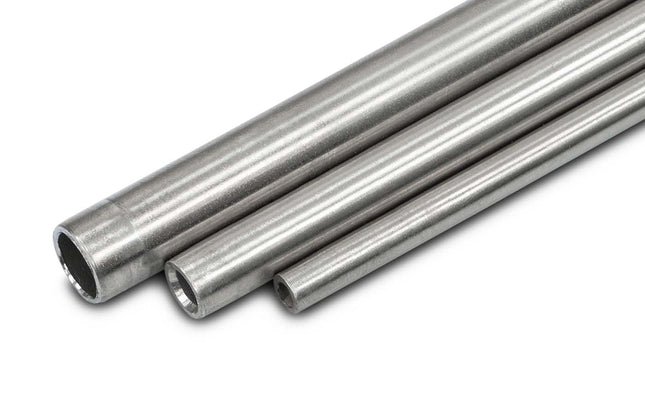
3/8" 316SS Hard Line Tubing 5FT
3/8" 316SS Hard Line Tubing 5FT Stainless Steel 316 Hard line tubing for compression fitting connections and systems. Specifications Length 5' Material 316 Stainless Steel ASTM A-269 Max Allowed Working Pressure (PSIG) 1/4" x .035 5100 1/4" x .049 7500 1/4" x .065 10300 3/8" x .035 3300 3/8" x .049 4800 3/8" x .065 6550 Burst Pressure Rating >4x Working Pressure
$40.00 - $100.00
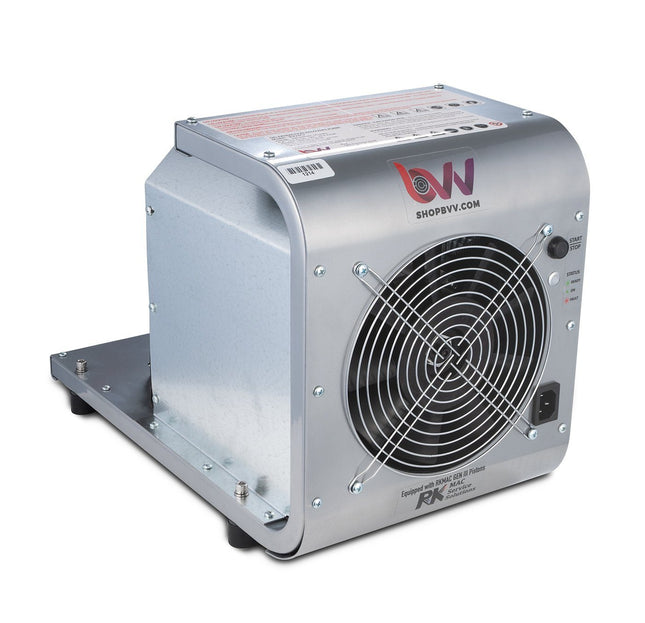
BVV 2 Cylinder Butane Recovery Pump - Meets ANSI 12.12.01
Butane Recovery Pump RECOVER MORE WITH LESS BVV is proud to introduce our new and powerful line-up of Butane & Propane Recovery Pumps. Blending compact design with improved Gen III Pistons from RKMAC, this collection of pumps can help you recover 1lb. of butane every 1:40 Seconds! This pump Assembled in the USA and all the critical parts are domestically made. Finding parts wont be an issue with this pump. The piston seals are rated to 450F and the average operating temperature of the pump is 175F leading to a long service life. Built to meet ANSI/ISA 12.12.01 for Use in Hazardous locations Class I & II, Division 2 and Class III, Divisions 1 & 2 environments. The computer controlled brushless DC motor operates at 3000 RMP nearly twice as fast as any other pump in its class. BVV Butane/Propane Recovery Pumps are: Process up to hundreds of pounds of vapor recovery before rebuild Equipped with oil-less reciprocating compressors for a clean product Designed and Assembled in the U.S.A. with domestic and global parts Affordable and highly cost efficient Available in 2-Cylinder, 4-Cylinder, CMEP Retrofit Comes with a 1-year Manufacturer’s Warranty covering Hemp usage Rated universal voltage 100-240V AC 50/60 Hz 1Ph Built with high efficiency Brushless DC Motor used for variable speed control Equipped with Viton O-Ring Seals for Butane/Propane gas and oil compatibility Piston Seal rebuild kits are USA made and available Part# BVV-3. Certified by ITS/ETL to ANSI/ISA 12.12.01 Noise level: 90.3 dB at 1m. Technical Data Sheet Product Brochure BVV™ 2 & 4 Cylinder Rebuild Instruction Manual *Butane recovery results were achieved on a collection base pressure greater than 30psi and using a recovery cylinder with a pressure <10psi. A dry ice coil was used in between the output port of the pump and the recovery cylinder to condense vapor.
$1,300.00
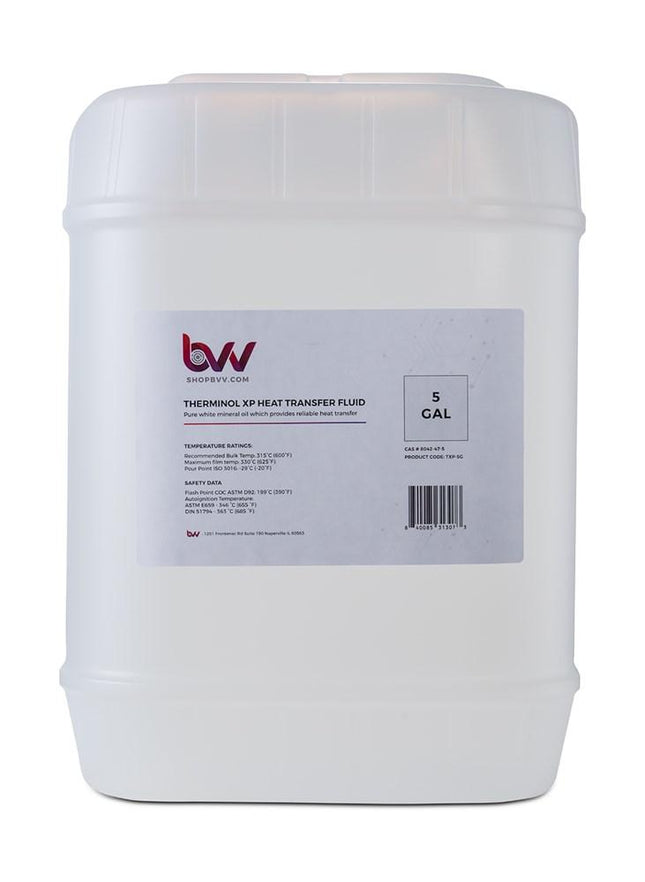
Therminol XP Heat Transfer Fluid
Product description Safety Data Sheet Technical Data Sheet Therminol XP heat transfer fluid is an extremely pure white mineral oil which provides reliable heat transfer. Performance Benefits Low Fouling— The chemical composition of Therminol XP has been carefully selected to minimize system fouling that results from oxidation and degradation of the fluid. Practically Non-Toxic— It meets the purity specifications in U.S. Food and Drug Administration Regulation 21 CFR 172.878 and is listed as a Registered Nonfood Compound by NSF International (Category Code HT-1: Heat transfer fluids - Incidental contact). Thermal Stability—Users can expect many years of reliable, trouble-free operation, even when operating Therminol XP continuously at the recommended bulk temperature of 315°C (600°F). Environmentally Friendly—Therminol XP has outstanding regulatory status for those seeking heat transfer fluids that have minimum environmental reporting requirements. Applications Adhesives Desalination Dryer heating Fatty acid HTF - bakery HTF - deodorizing HTF - deodorizing oil and fat HTF - edible oil HTF - food production HTF - food/feed/beverage processing HTF - production of bioalcohol HTF - production of biodiesel Industrial Peek (polyether ether ketone) Phthalic anhydride Polyester (PET) Specialty and batch chemical production Specialty chemicals Key attributes Environmentally Friendly Low Fouling Practically Non-Toxic Thermal Stability
$150.00 - $4,000.00
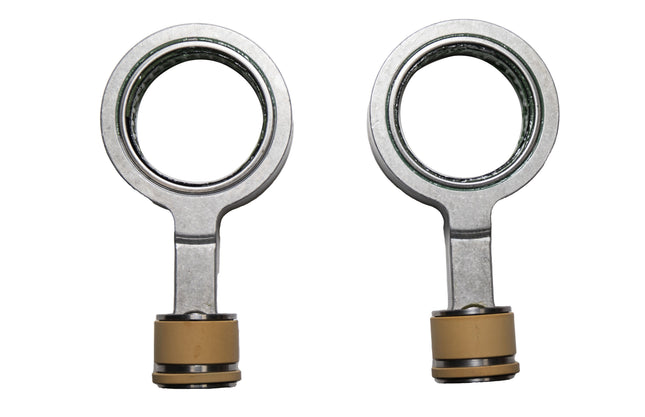
TRS21 / BVV Upgraded Stainless Steel 2-Piece Piston and Rod Design for Hydrocarbon Extraction
BVV-1 Included in this kit: Complete connecting rod assemblies with 2-piece SS piston, piston seals, and viton o-rings. This upgrade kit can be used for the following recovery pumps: CPS TRS21 Anti-spark/explosion pump BVV 2 Cylinder Butane Recovery Pump ITS/ETL to ANSI/ISA Certified BVV 4 Cylinder Butane Recovery Pump ITS/ETL to ANSI/ISA Certified - Requires 2 kits because this unit has 4 cylinders. Looking to rebuild your TRS21 and want to upgrade to a more efficient and longer lasting piston/rod setup? This kit comes with a fully assembled connection rod and 2 piece piston. The piston is made out of SS making it a great choice for any application where bacterial growth must be eliminated. This design focuses on long life piston seal and wear band. This kit utilizes a Viton energized o-ring specifically designed for butane and or propane recovery used in the extraction process. By utilizing this kit the piston seal and wear band can be easily removed without having to disassemble the rod from crank. An inexpensive tool (*NOT INCLUDED* SKU: BVV-TL1) is required to rebuild the seals next time service is needed. The tool uses two posts to lock into the top of the piston and a 5/8” Hex heat to remove the top part of the piston. If you would like to purchase both the piston/rod assembly and tool it’s (SKU:BVV-K1). If the tool is not used the customer is responsible for all damage done to piston. After this has been done the wear ring can slide out and the piston seal can be replaced with a new one, the kit can be purchased for all future piston seal and wear band rebuilds (*NOT INCLUDED* SKU: BVV-3). Loctite 242 (*NOT INCLUDED) will also be required for proper installation. A test was performed between the OEM piston and seal design and the BVV. Results show that the BVV had a much less leak rate than the OEM design. After hours of use the leak rate of the OEM design was unable to recover the complete initial solvent batch. This affects the efficiency of the recovery process.
$185.00
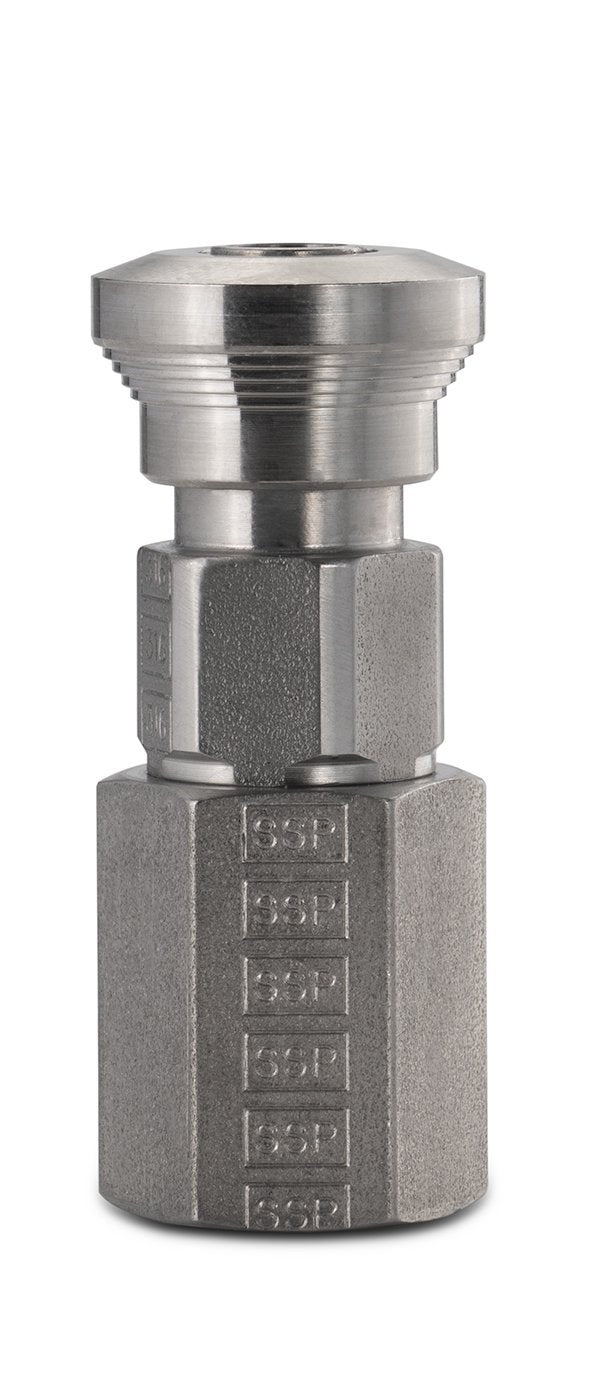
Quick Disconnect - Female NPT - BODY
SSP Quick Disconnect - Female NPT - BODY SSP Instrumentation Flolok® Quick Connects are designed to provide a convenient way to connect and disconnect fluid lines, creating a leak-tight seal without the use of tools. Features: Viton® (Fluorocarbon FKM Rubber) O-Rings Provide Leak Tight Sealing DESO (Double End Shut Off) design Push to connect means no tools required Pressures up to 3000 psig Specifications: Material 316 Stainless Steel Pressure Rating 3000 PSIG Connection Type 1 Body - Shut Off Connection Size 1 Specified by User Connection Type 2 Female NPT Connection Size 2 Specified by User Connects Stem to Male NPT O-Ring Material Viton®(FKM) SSP proudly makes Duolok®, TruFit®, FloLok® and hundreds of other products 100% in the USA!
$45.00 - $90.00
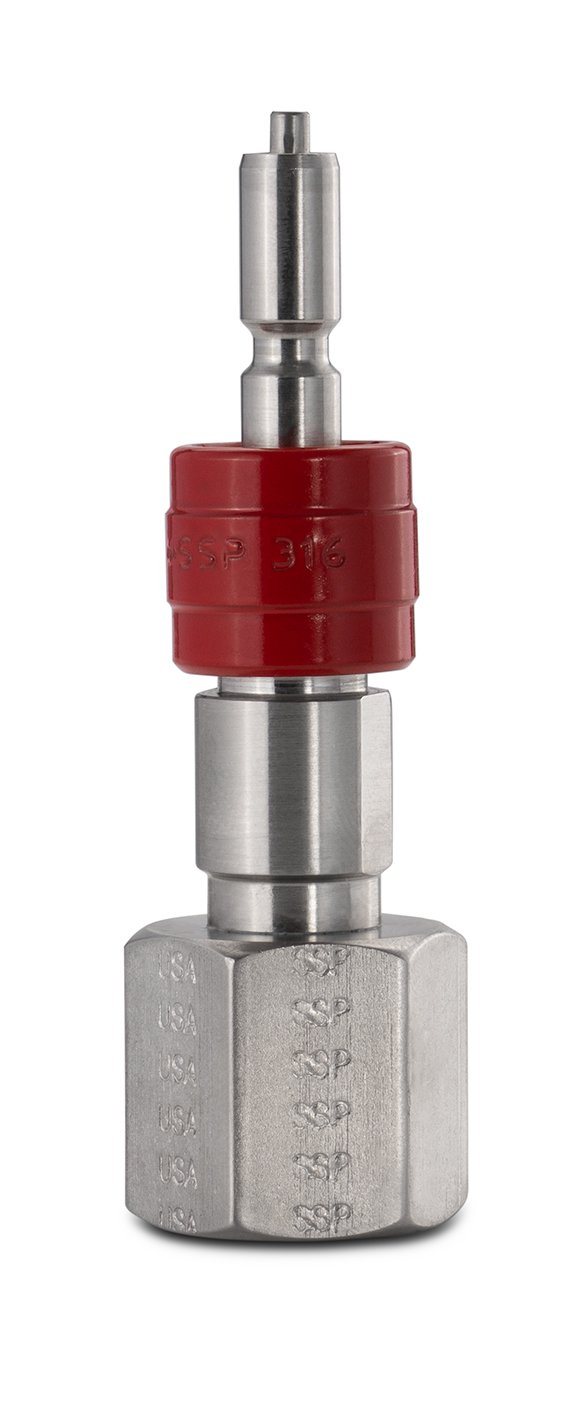
Quick Disconnect - Female NPT - STEM
SSP Quick Disconnect - Female NPT - STEM SSP Instrumentation Flolok® Quick Connects are designed to provide a convenient way to connect and disconnect fluid lines, creating a leak-tight seal without the use of tools. Features: Viton® (Fluorocarbon FKM Rubber) O-Rings Provide Leak Tight Sealing DESO (Double End Shut Off) design Push to connect means no tools required Pressures up to 3000 psig Specifications Material 316 Stainless Steel Pressure Rating 3000 PSIG Connection Type 1 Body - Shut Off Connection Size 1 Specified by User Connection Type 2 Female NPT Connection Size 2 Specified by User Connects Body to Male NPT O-Ring Material Viton®(FKM) SSP proudly makes Duolok®, TruFit®, FloLok® and hundreds of other products 100% in the USA!
$65.00 - $70.00
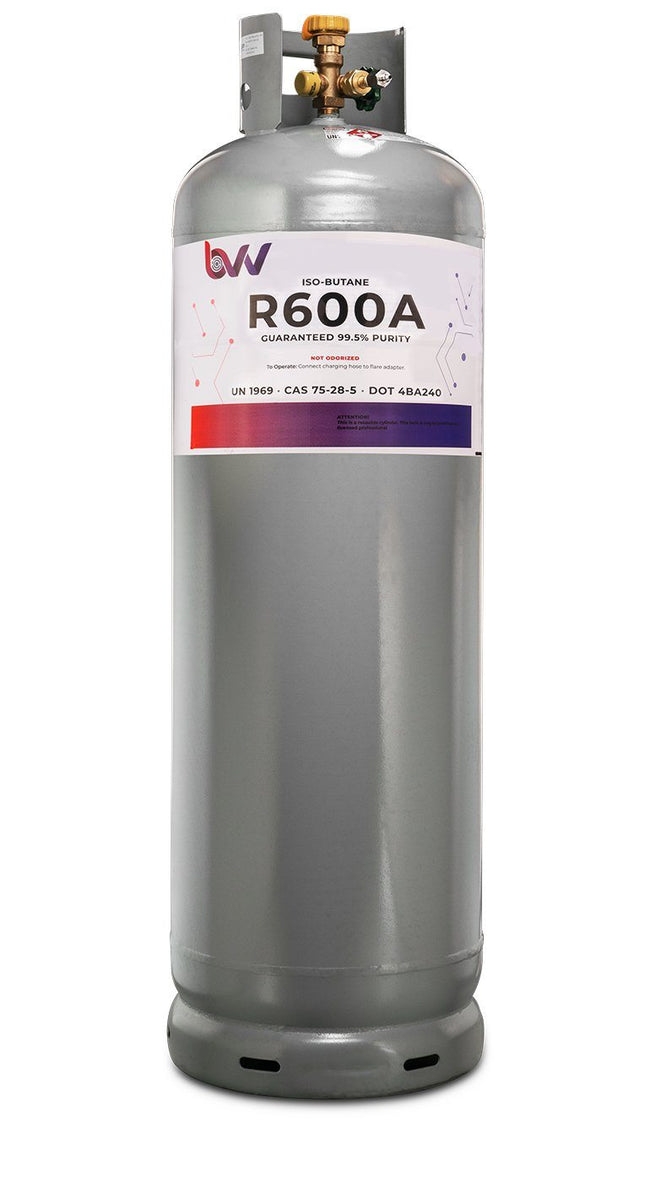
120LB DIPTUBE Tank High Purity USA ISO-BUTANE R600A - 99.5% Guaranteed
120LB DIPTUBE Tank High Purity USA ISO-BUTANE R600A DIPTUBE- 99.5% Guaranteed DISCLAIMER(S): This unit is intended for LEGAL purposes only, to be used in accordance with local laws and ordinances. Use only in WELL VENTILATED AREAS! Notice: This item will ship via Freight ONLY. BVV™ always recommends distillation of every solvent before use. Tank does not include CGA 555 fitting. Must be added through dropdown or bought separately. California now prohibits the retail sale of any Non-Odorized butane in quantities larger than 150ml. If you are not a retail purchaser you can call in to place an order. Permitted Sales Include the Following: Medical Collectives or Cooperatives operating under CA Health & Safety Code Section 11362.775 Persons licensed to perform volatile solvent extraction activity under CA Bus & Prof Code Division 10 Manufacturers, wholesalers, resellers, or retailers solely for the purpose of resale At Best Value Vacs, quality is everything, and our ISO-Butane is certainly no exception. This ISO-Butane is sourced here in the U.S, so you know it’s going to be of high purity: we guarantee 99.5% purity. With such high quality, you’ll see the results. By cutting down on mystery oils and other contaminants, our instrument-grade solvent will make for a higher quality extract. This solvent is clean, odorless, and colorless, meaning there are zero hydrogen sulfide-based Ethyl Mercaptan odorants. It’ll arrive in a DOT refillable LP tank. Typical Analysis: ISO-Butane >99.8% Methane <1 ppm Ethane <1ppm N-Butane <2000 ppm Propane <250ppm Isopentane <2 ppm Water <3 ppm CO+CO2 <5ppm Oxygen <5 ppm Nitrogen <10 ppm Sulfur Non-Detected **Notes: Actual ISO-butane liquid weight is 116LB Best Value Vacs always advises distillation of every solvent before using it. DISCLAIMER: Our items are intended for LEGAL purposes only, to be used in accordance with local laws and ordinances. For safe operation, only use the unit in well-ventilated areas. ***Shipping Notes: This item will ONLY ship via UPS Ground, in accordance with FAA regulations. Any orders including solvent will NOT be shipped Expedited. If an order includes solvent as well as additional items, it will all be shipped via UPS Ground/Freight even if you’ve selected Expedited. If you want the non-solvent item to ship Expedited, place 2 separate orders; we won’t split up orders and ship them separately otherwise. We do not ship solvents to Hawaii, Puerto Rico, or any other U.S. Territory outside of the contiguous 48 States. Shipping solvent to Alaska will ONLY be via freight and will be required to travel through Canada. Our shipping policies are in place to ensure safe transport of solvents and prevent any problems with shipping times for Best Value Vacs customers Chemical Formula: C₄H₁₀ Molecular Weight: 58.12 g/mol CAS Registry Number: 75-28-5 Appearance Colorless Odor: Faint Petroleum Density 563 kg/m³ (or 0.563 g/mL) Boiling Point: 10°F (-12°C) Solubility in water: Low Solubility GHS Pictograms: GHS Signal Word: Danger GHS Hazard Statements: H220 GHS Precautionary Statements P203, P210, P222, P280, P377, P381, and P403 UN Identification Number: 1969 Proper Shipping Name: Isobutane, liquefied Transport Hazard Class: 2.1 Packing Group: None DOT Placard: Isobutane Certificate of Analysis (COA) Isobutane Safety Data Sheet (SDS)
$590.00 - $600.00
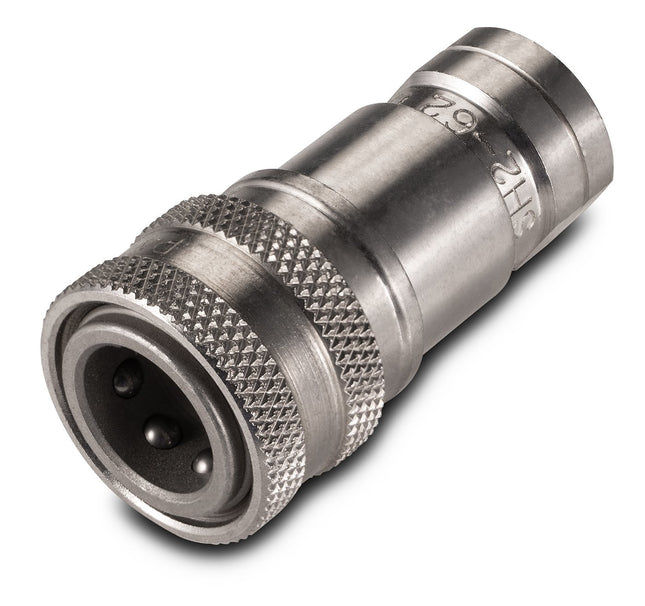
1/4" Female NPT Parker Quick Disconnect - BODY
1/4" Female NPT Parker Quick Disconnect - BODY 60 Series Couplers (hydraulic, fluids, gas, steam) up to 5000 psi, connect with ISO 7241 seriesB, 60 Series Nipples. Parker's 60 Series bave double shut-off poppet valves and are interchangeable with other quick disconnects complying with ISO Series B. These general purpose quick couplings are available in a wide range of sizes and materials to be versatile for use with several fluids, including high temperature steam. Parker's 60 Series is multi-purpose for a vareity of applications and pressures up to 5000 PSI. Steam version couplers are brass with double interface O-rings and stainless steel locking balls. Seal material is Ethylene Propylene and 3/8"" size has a grip-ring sleeve for easy operation when wearing gloves Technical Specifications: Maximum Working Pressure (PSI) 5000 Maximum Working Pressure (BAR) 340 Flow Rate (GPM) 3 Flow Rate (LPM) 11 Media Hydraulic Industry Standards ISO 7241-1, Series B Coupling Half Coupler Minimum Working Temperature (F) -40 Minimum Working Temperature (C) -40 Maximum Working Temperature (F) 250 Maximum Working Temperature (C) 121 Valve Style Poppet Sleeve Type Manual Sleeve Locking Mechanism Locking Balls Vacuum Rating (INCH of HG) 27.4 Vacuum Rating (BAR) -0.9 Thread Style Female Technical Characteristics Sizes: 1/8" - 2-1/2" Materials: Steel, Brass, 303 Stainless Steel, 316 Stainless Steel Port Ends: Female NPTF, Female ORB Seal Options: Coupler Options include: Markets Industrial Construction Chemical Processing Commercial Cleaning Agriculture Features/Benefits: Globally interchangeable with other manufacturer's couplings complying to ISO 7241 series B Multi-purpose coupling, widely used in varied applicationsSteel couplers have a hardened sleeve for strength and durability Metal valve stop prevents flow checking to provide steady performance Steam version couplers have Ethylene Propylene seals to withstand high temperatures and the 3/8"" has a grip-ring sleeve for easy operation when wearing gloves. Brass couplers have double O-rings for redundant sealing and stainless steel locking balls for corrosion resistance 316 Stainless Steel couplers have Flourocarbon seals for checmical compatibility Optional coupler sleeve lock helps to prevent accidental disconnection Applications Industrial hydraulic lines Food and chemical processing Water and coolant lines High pressure fluid transfer High temperature fluid transfer Mobile equipment Cleaning equipment Dry cleaning Steam Systems
$103.00
You have seen 48 out of 202 products
















































